Wolf in India
-
blues2cruise
- Moderator

- Posts: 10182
- Joined: Fri Apr 22, 2005 4:28 pm
- Sex: Female
- Years Riding: 16
- My Motorcycle: 2000 Yamaha V-Star 1100
- Location: Vancouver, British Columbia
- noodlenoggin
- Legendary 300

- Posts: 415
- Joined: Mon Jul 17, 2006 2:08 am
- Sex: Male
- My Motorcycle: 1995 Ford Thunderbird =-(
- Location: Lithia, FL
- sv-wolf
- Site Supporter - Platinum

- Posts: 2278
- Joined: Sat Dec 13, 2003 2:06 am
- Real Name: Richard
- Sex: Male
- Years Riding: 12
- My Motorcycle: Honda Fireblade, 2004: Suzuki DR650, 201
- Location: Hertfordshire, UK

22nd Feb
Day 1 of the Rally
Start: Old Anchor Hotel, Kavellosim (Goa)
Finish: Beach Huts on Palolem Beach (Goa).
Distance: 184 km on the clock, 20km as the crow flies.
“Today is designed to break us all in gently. This rally stage sees us tackle a beautiful and demanding stretch of the Western Ghat mountain range on our way to Palolem, our first night’s destination. Palolem is one of India’s most beautiful beach resorts. During the riding day you will encounter mountains every bit as spectacular as the Himalayas, just with lots and lots of forest and no snow peaks, due to the reduced altitude. Today is short in length to give us all a chance to build confidence. It is a stunning and remote ride. Get ready for very rough accommodation and a breathtaking location tonight – the rally has begun.”
From The EnduroIndia Roadbook 2007
I woke up feeling pretty damn excited this morning. I was just aching to get my teeth into an adventure. It had already started in my head - and in the rest of me as well. I could feel the energy fizzing in my muscles. I could feel it in my bones. ‘India! Indiaaahhh!’ There was, however, just one little issue – how was I to get out of bed? You may laugh, but this is a serious ergonomic problem that I face every morning of my life.
If I were at home right now, the dominant part of my brain would be reasoning thus: The Adventure is already going on in my head. My head is happily lying on my pillow. Ergo, there is no conceivable reason why I should get out of bed. (It’s amazing how practically useful a dry-as-dust degree in Philosophy can be sometimes.) But I wasn’t at home, and the real world was yelling at me from beyond the curtains to get up and join the party.
With a kind of overmastering impulse that came out of nowhere, I swung out of bed. I stood upright, rubbing my eyes and blinking at the world as I imagine the first man must have blinked at the moment of his first awakening into consciousness. I even got through those critical first two minutes of the morning without bumping into anything or collapsing back down onto the mattress. Some serious business was going down.
Pip was already bustling around in the bathroom. I could hear the sleepless bulk of Brian next door shifting himself out of bed like a lead weight. There was already a clattering on the stairs and on the paths outside our chalet as other Enduros were making their way across to the outdoor breakfast tables. Within moments I was fully awake and packing, washing, dressing and hauling my luggage down to the hotel reception where it would be picked up by the trucks. It would soon be on its way to tomorrow night’s destination – Om Beach. For some reason it wasn’t going to where we would sleep tonight - a collection of huts on Palolem beach, “very rough accommodation” according to the Roadbook. We were advised to take our sleeping bags with us on the bike.
Sambhar for breakfast again! As I said, I like this curried food but…
It wasn’t fair! Everyone else was wolfing down platefuls of scrambled egg and big rounds of bread. But not me! I was doing what all nineteenth-century British colonial administrators in India feared. I was ‘going native!’ I couldn’t eat the scrambled eggs because the hotel chefs had cooked them with milk, and I am seriously allergic to dairy products. So I had no choice. Curried breakfast it was, to be followed – no doubt about it – by curried lunch and curried tea, and curried dinner too. On the bright side, they were serving some sausages! Yummy! Sambhar and chicken sausages! There’s not a lot of pork to be had in India, so most sausages here are filled with chicken meat. Different, but tasty!
Where was Larry? Larry and I had met up in the hotel reception yesterday. Larry was probably a little older than me. He was looking for someone who roade at his pace. He said he was a slow rider. I’m not so slow, I told him, but I would probably end up at the back of the pack because I intended to spend a lot of time taking photographs and talking to people. He said fine, and we agreed to ride together. The arrangement suited me well. I didn’t want to ride with a big group because it would be more difficult to stop when I wanted.

Larry
The EnduroIndia team had insisted that we ride in groups of at least two in case of an accident. That was partly for obvious reasons, but partly also because there had to be someone on hand to prevent the ever-helpful locals from taking charge - moving someone when they ought not to be moved, or whisking them away to some unknown hospital, where no-body knew where they were. And there were other issues. Put it this way: getting vaccinated against Hepatitis C is often recommended if you are travelling to India. It’s not a big risk - unless you are whisked off to an Indian hospital.
EnduroIndia had two ambulances and a medical crew who constantly rode up and down the route. There was never a medic more than a few minutes away. In case of an accident, we were advised, it was best to give them a call on your mobile and let Doc, or Kip or Andrew or one of the nurses or paramedics deal with the situation and make the medical decisions.
Larry is a genial but reserved American (I’ve not met many of those.) He told me he was from Chicago originally, but had built up a business in London and had lived there with his wife for the last 20 years. He sounded very American to me and he had a very unBritish sense of humour, but as I got to know him over the two weeks of the Enduro it became clear that his adopted culture had rubbed off on him to some extent and he had acquired something of a European perspective on the world.
He almost hadn't come out to India. After booking his place with Simon (the guy who owns and runs EnduroIndia) he had suddenly developed some serious reservations about the whole trip. It took all of Simon’s powers of persuasion (and believe me, they are considerable) to get him out here. Larry is relatively new to bikes, but has ridden a trike back home in London for some while. (Riding a trike in London sounds like my idea of a nightmare – but Larry said he loved it.) The main thing though was that he was out here. And being here he had no intention of spoiling his trip by having and accident. Accidents are common on the rally, so he took to riding very carefully.
This first, proper day’s riding was going to take us on a long ‘U’ shaped journey directly up into the mountains through the towns of Panaji, Old Goa, and Ponda, and then back down to the coastal plain via Cancona. That’s a total riding distance of 184 km - except for those that got lost, of course. (And we were assured by Simon that many of us would get lost – Simon is endlessly reassuring.) But Palolem beach, our destination, is only 20 km down the coast from Kavallosim our starting point – a reminder that the best journeys are taken for the journey’s sake and are not just a way of putting distance between us and our beginnings.
At least that’s the way I think about it. We were a mixed bunch of riders, composed of everything from full-time racing professionals down to complete novices. At the one extreme there were the total bike junkies, those that might have been on the moon for all they cared. All they were interested in was the ride (and the beer, of course!). If India had looked to them exactly like the Nurburgring, they would have been completely satisfied. Up there with the junkies were the speed freaks and the goal-oriented achievers. These guys would be soaking in the showers at Palolem before the rest were even half-way home.
At the other extreme were The Travellers. You could tell The Travellers because they were festooned with cameras. They carried guide books in their tank bags and had a good line in conversation. Their often dreamy eyes lacked the sportsbike rider’s slightly crazed and focussed look. Riding with The Travellers would be most of the novices (though some of the completely new guys rode extremely well) and the genuinely easy-going souls who couldn’t work out what the hurry was all about.
In temperament, I would place myself somewhere in the middle, or more strictly, I’m a bit of both. The paradox of my life (and I'm still trying to sort this out) is that I have a nervous system that is so sparky it seems to have its own amphetamines supply, but a disposition that is never really in much of a hurry to do anything. On a bike, I never know whether to crack open the throttle or just saunter along and take in the view.
India magnified my perennial state of indecision. What should I focus on: the ride or on the scenery? Both were magnificent. But, sure as eggs, I couldn’t do both at once. So, I alternated every day between the two. In practice, though, I usually ended up at the back. (It’s just in my nature, I can’t help it) And I mean - right at the back! with the EnduroIndia ‘Back Marker’ drumming his fingers on his tank while I got off the bike to take one more photograph or chat to one more group of people, or just to get soulful for a while up in the mountains. Even Larry sometimes got just a little bit frustrated with me, I think.
I mopped up the last of the sambhar with the idli, gulped it down and made my way over to the field where the bikes had been rearranged into a giant arc. It was a dramatic sight. Every bike had a newly blessed garland of flowers hanging from the bars and around the headlight. (A Hindu holy man had come and done the honours with great ceremony the previous evening.)

The first day meet opposite the hotel
I started the bike a lot easier today. I could fire it up in about a minute now, and Sonny had more time to see to other business. I was confident that I’d got the left-right, down-up business with the gears sorted out in my mind, so my nerves were a lot less tight than it had been the day before. (I was to have the occasional high-revving, gear-crunching and sharp-braking moment almost to the end of the rally, but mostly I’d got the measure of the bike by this second riding day.)

Ben again, looking thoughtful (total squid who surprised everyone with his riding)
The extroverts among us were already beginning to reveal themselves. Toby and David’s bikes were already rather more decorated than the rest. And it wasn’t difficult to spot Kevin, Justin, Colombo and several others from their crazy riding gear. Ali was there with her camera. So were the other ‘official’ photographers. The video crews were lumbering around with all their equipment; the mechanics were roving about, eagle-eyed in their orange tabards; the team were swanning around in their yellow ones; the ambulances and medics were waiting near the entrance. And the whole shebang was just about ready to roll.
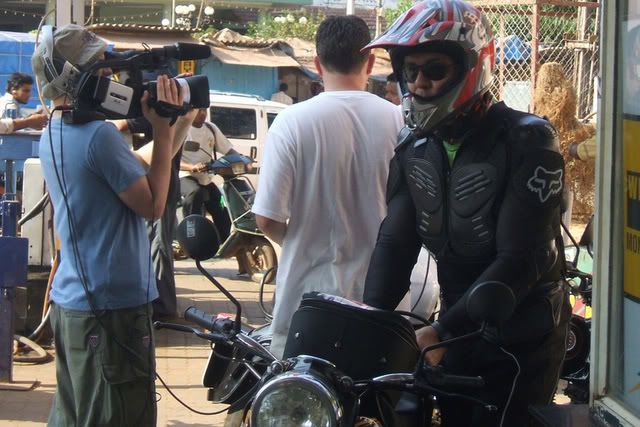
The EnduroIndia camera crews got everywhere. Every year the organisation makes a film of the event and shows
it in a London cinema. They also produce a DVD.
Once we were away from Kavallosim and the hotel, we emerged quickly onto a busy main road. The column of bikes began at once to string itself out as the front runners forged ahead. For the first 60 kilometres or so, the route lay along fairly major roads and gave us a more developed taste of Indian driving skills, like the easy habit of making blind double overtakes (one vehicle overtaking another, which was in turn overtaking a third on a blind corner.)
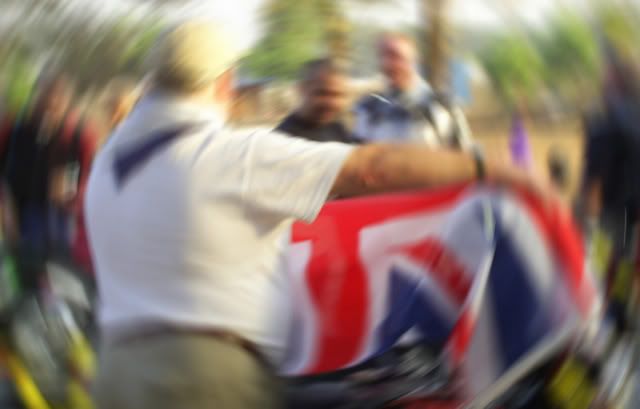
No prizes for guessing where this guy is from
The land soon began to rise steadily but not steeply. With greater confidence today and on roads like these, my modest desire to stay alive was now being replaced by some rather more natural biker instincts: like the instinct to ‘make progress’ and to overtake. It was a great feeling, bowling along these roads with so many other bikers out here in this amazing country. And of course, it was another lovely day. But so were they all - all lovely days.
At thirty-two kilometres we made our first major river crossing. The rivers here are wide and magnificent. At the lower levels the palm forests sweep down right to their banks. At higher altitudes deciduous forests blanket them on either side. I stopped on the far side of the bridge for a break and to take a few photographs. There aren’t that many broad, powerful rivers like this in the UK. (I remember, at the age of seventeen, being miffed when an American friend referred to the Frome, one of the major rivers of southern England, as a ‘creek’.)
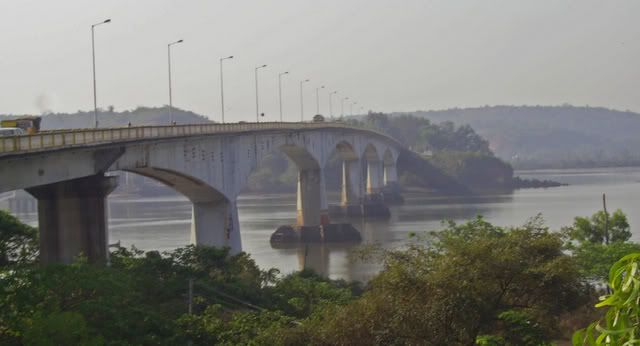
The first river crossing
But I’d stopped also for another reason. My new helmet was a white off-roader. I’d bought it specially for the rally because I reckoned that it would reflect the sun and allow air to circulate well. It was doing those jobs OK, but right now it was beginning to give me a sharp pain in the side of my head. It had felt fine when I bought it and when I’d worn it for half-an-hour or so at home, but not now. I’ve got a very round (Arai) head and the new lid was clearly the wrong shape. Damn! Not the best of times to find out. There wouldn’t be much chance of buying a new lid before the end of the rally. All I could do was to thumb the lining material and try to widen its inner profile slightly. It worked – a bit. But I had to keep doing it right throughout the trip, and I never got an entirely pain-free ride after that. Once I’d worked on the inside of the helmet though, the pain was mild and most of the time I was able to ignore it. When I couldn’t, it was a matter of shifting the helmet around so that the pressure wasn’t concentrated on one spot.
While we were standing by the side of the road with a lot of other Enduros one of the mechanics happened by. The mechanics always stopped when a group of us were taking a break and did a visual check on the bikes. One of them noticed that my front tyre was slightly flat - just very slightly. I hadn’t realised myself. I gave it a kick. How could he tell? It looked fine to me. I rode the bike a couple of hundred yards down the road to where their van was parked and one of the mechanics checked it. Sure enough it was a little low and he put a few extra PSI in it with a foot pump. “Keep an eye on it,” he warned.”
Well that would give me something to think about. I now had a tight lid and a slow puncture.

Taking a break on the way into Old Goa
Eighteen kilometres further on and we were running among some very heavy traffic alongside another wide river. This was the approach to the town of Old Goa. Old Goa still had a very European feel about it. The large Cathedral and various other major buildings were clearly of Portuguese origin. The town had wide streets with well-manicured verges and was exceptionally clean for India.
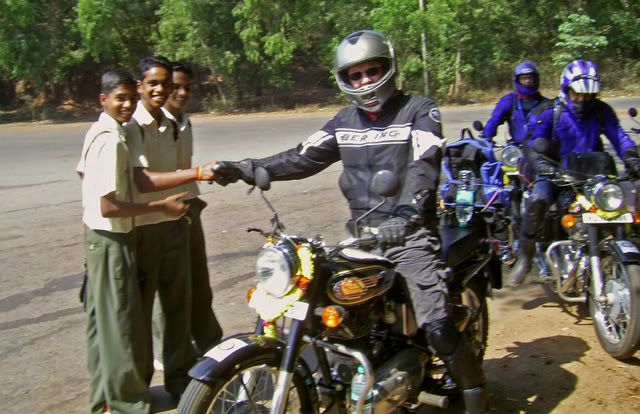
Larry amusing three schoolkids. When they asked him where he was going, he had to admit
that he didn't know
On the outskirts of Ponda, the next town, we stopped to discuss the Route Plan which was suggesting we should carry straight on past a junction and through Ponda, itself. Despite the confidence of the instruction the road layout proved it to be a complete nonsense: ‘straight ahead’ was not going to go anywhere near Ponda at all. Various other groups of Enduros had pulled over to ponder the same problem. The Route Plan was generally very good but not always. A proper map would have been useful at this point, but when I asked the EnduroIndia team a little later why they hadn’t given us one, I was told that maps which included the minor roads just did not exist. I tried to think of a map of Hertfordshire without the B roads on it, and I felt a certain insecurity coming over me. Arriving here from a world of information overload the idea of a vast country like India that was mostly unmapped was fascinating, and also reassuring. I sometimes think the less we know about things the less we can "fudge" them up.
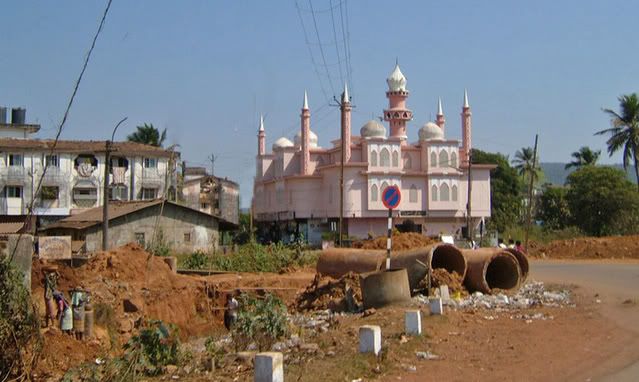
India: graceful and filthy, orderly and chaotic; these contrasts were everywhere
I tried asking a truck driver how to get to the next town. He was pulled up by the side of the road and relaxing in his cab. He didn’t speak English so we didn't get very far. Showing him the Route Plan and waving my arms about didn’t work either. But he eventually caught the word ‘Molem,’ the name of the next town, and he suddenly brightened. Once again I was taken aback by the depth of the Indian desire to be helpful: the look of relief and excitement on his face when he understood what I wanted was astonishing, and he took obvious pleasure in pointing out the way for me.
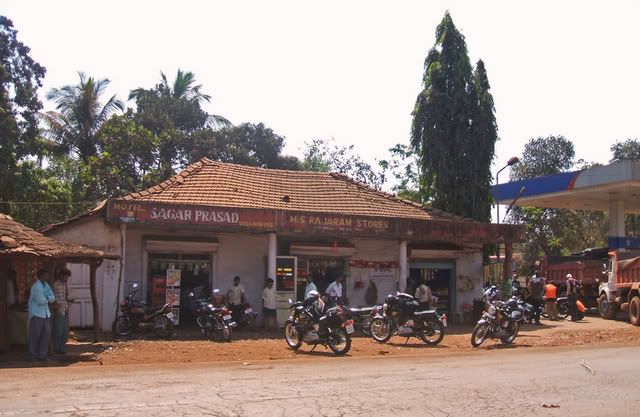
Molem-A dusty truck stop town
We’d been seeing trucks all day, compact-looking six or eight wheelers, carrying various loads, but often piled high with the red soil that seemed everywhere in this place. On the way into Molem we passed so many trucks going in both directions that they seemed like two continuous convoys.

Molem again - the trucks rumbled through continuously all the while we were there
Molem turned out to be a dusty truck-stop town in the middle of nowhere. It had a petrol station and some small kiosks selling food and drink. I needed to fill up with petrol and I wanted to get my front tyre pressure looked at again. It seemed OK, but I had begun to convince myself that maybe it wasn’t. For the last fifteen kilometres the road had been rough and heavily potholed. I hadn't noticed last time and it seemed likely from the meagre information provided by the Route Map that there wouldn't be another garage for miles. I queued up. As it turned out there was no air pump at the fuel station but it did mean that we got to hang around this amazing place for half-an-hour or so.
Larry bought a bunch of tiny bananas from a kiosk for 2 Rupees each (about 2p or 3 cents) and shared them out. I’ve never seen such tiny bananas. They were no more than two or three mouthfuls each. I guess they are probably harvested wild here. They are probably not commercially viable for transportation over long distances. But they were fine. We found them everywhere after that. They would form a good part of our diet while we were on the road from that time on. Fruit is sterile so long as the skins are still intact when you buy it, and here in India bananas are nutritious and plentiful.
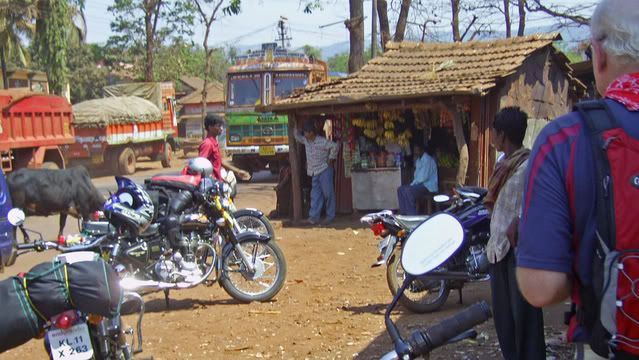
Larry thoughtfully considering the mini-bananas in Molem
At Molem we turned off the main road and off the main truck routes as well. Three of four kilometres further on I saw my first elephant. It was chained up by the side of the road dozily pushing a scattering of hay about the floor. John and Julia had passed us while we were still in Molen and had ridden this way about twenty minutes earlier. Julia had asked to be given a ride on the elephant's back. She has sent me a disc of her photos. This is hers.
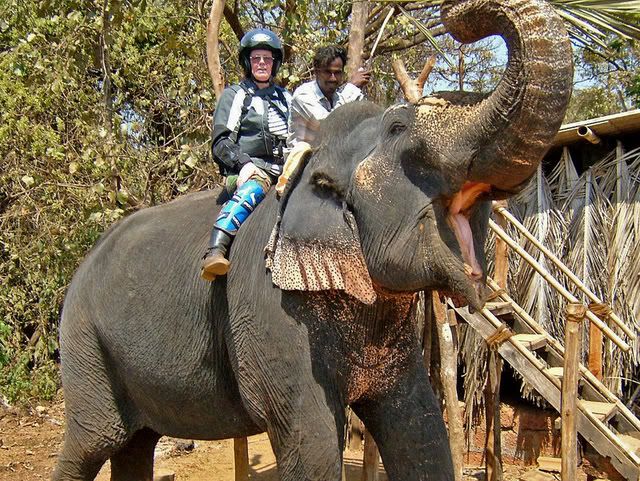
Julia's Elephant GP
After Molem came Colem, and after Colem came miles of deciduous forests and rolling hillsides, which got thicker and more beautiful as we rode deeper and deeper into the mountains. The narrowing roads were soon crowded on both sides by trees and shrubs and dense foliage of all kinds. We turned right by a sign announcing “road improvements” then made a quick left. And straight away we were rolling downhill and onto a road that was still waiting to be improved. It was no more than a rough track of loose soil, cut about with huge ruts and potholes. The change was completely unexpected. The Route Plan had given no warning of it. In a matter of a few yards the rules of the game had suddenly changed. It was a different landscape and a different biking experience.
The moment we hit the track, my body went straight into emergency mode. The easy-going ride was over. For the next few minutes I was too focused on the ruts and shifting soil, and too busy trying to stay upright, to notice immediately that my anxiety levels had suddenly risen exponentially. I’d never ridden on this kind of track before. Where it was dry the ground threw up clouds of dust, where it was wet there was a red oily slick.
It soon became apparent though, that the Enfield was perfectly at home on this kind of surface - more at home than I was, and more than I would have ever imagined any road bike could be. I began to relax a little. And then a little more. Suddenly I found it exhilarating. The Enfield was hilarious! It tackled this stuff without the slightest difficulty and it handled just beautifully! What a bike!
We turned under a bridge and found ourselves running parallel to a busy railway goods yard. There seemed to be a lot of raw material haulage around here though I couldn’t make out exactly what it was. More of the red clay, perhaps? They must need a hell of a lot of bricks in Goa. The route kept us turning off one narrow track onto another, each one narrower and more remote seeming than the last. And suddenly we were completely lost in the middle of rural India. The rough, and occasionally sodden, surface continued, though it wasn’t for another seven kilometres that our Route Plan made mention of the fact with a single, innocent-sounding instruction: “Continue along muddy track.”
There wan't anything else to do. Eventually we hit another junction. this time we turned onto a broader track, but one that was equally dusty rutted. And here we began to meet the trucks again. They came rolling down towards us in twos and threes – dozens of them – travelling at speed and flashing their headlights at us. In India when a vehicle flashes its headlights like that it means only one thing. It means: I’m coming through – GET OUT OF MY WAY! And that is what you have to do; you have to get out of the way, even if it means riding into the hedge - because they are not going to stop.
The trucks were everywhere along this stretch, bouncing along at lunatic speeds. And rarely on the right side of the track! (Was there a right side of the track?) Most were painted a vivid red and decorated from top to bottom with all sorts of graphics. They were a real hazard to life and limb. But already I began to notice a perverse kind of idea growing in my mind: dodging them was beginning to feel like a lot of fun.
Most of the trucks also had some sort of slogan painted on them in English or in Indian script. I recognized some of the English slogans from roadside signs. They were all very worthy and comtemporary. I was told later that there was a practical reason for this. In India, trucks have to pass a regular MOT test (I'm not sure what the American or Canadian equivalent is – here in GB, it’s a yearly legal examination of all vehicles over three years old to make sure that are still road worthy.) I was told that the government officials who conduct the MOT tests here in India were unlikely to pass a truck unless it was carrying one of the current government’s slogans somewhere about it. That is downright corruption, like the way the ruling party uses Dordoshan the state TV system. Corruption here runs right through the entire political and business system from the bottom to the very highest levels. Everybody know it, everybody makes loud, morally outraged comments about it, but everyone turns a blind eye, or milks the system.

Goan roads are dominated by trucks
Indian trucks, I was told before I came out here, rarely have rear lights of any kind. My two weeks experience in India allows me to reveal that this is not strictly true. Most of the trucks we saw did have very colourful lights - but they were usually painted on! This place is glorious!
As we rode down the dusty track my spirits soared. Just one day into the rally and the Bullet was already beginning to seem like an old friend. I was already riding with so much more confidence that I had expected. Once the intial anxiety had worn off I was beginning to seriously enjoy this kind of riding. The day was beautiful. But that meant it wasalso thirsty work and I was beginning to get a bit fed up with the sun-heated water in my Camelback water carrier. So despite my good mood I was beginning to think that I needed to stop. Then, out of nowhere, we hit the village of Uguem and the Sunil Bar. Time to pull over. Others had had the same idea: there must have been a good twenty Enduros hanging out there already, all looking pretty floppy from the heat.
My sense of hygiene is, I would say, averagely male. I take sufficient care to prevent myself and others succumbing to a lot of unnecessary diseases, but on the whole, my awareness of being beset by germs is not particularly well developed. I don’t have nightmares about doing battle with armies of invading bacteria – like a friend of mine. That’s not me.
If you grow up in the countryside, you don’t get to fret about that kind of thing much. At least I didn’t. Nor did my folks. I passed many happy childhood hours rolling about in swampy pools, in rotting spinnys and in tic and lice-infested pastures. And I took particular pleasure in wading up and down smelly drainage ditches for hours at a time, exploring the mud at the bottom. We lived in a house which had pasture land on three sides of it. And when you are literally surrounded by domestic farm animals (not the most hygiene-conscious of creatures) every day of your life you can’t avoid being in contact with a fair number of wee critters. I was always falling into cow pats as child, I seem to remember, and survived perfectly well to tell the tale. I think that living among a thriving community of bacteria is useful for building up your immune system.
But… Hygiene in India is something else. We had been advised by the EnduroIndia medical crew not to eat salads, and most definitely not to eat meat unless we had seen it cooked in front of us. We were not to drink directly out of bottles unless we had a straw, nor to have ice in our drinks, nor to buy water unless we were sure the seal on the bottle was unbroken (otherwise its contents were likely to have come from the local river). And there were a dozen other rules as well. It all seemed to require a lot of care and attention. And I’m not very good at ‘care and attention’. But once you have spent a little time here, you begin to appreciate the need.
It is one of the paradoxes of this endlessly confusing country. Hinduism, the majority religion, has a very well developed sense of personal ‘purity’. People you see on the streets here are often extremely clean and well turned out, yet India itself is filthy. Take the Sunil Bar, for instance, where we had just stopped off for a break. It's in the photo below. The shop is on the left-hand side. It's open-fronted and sells a few meagre items of food and drink. It must have been doing a fair trade that morning as there were crates of empties piled all around it. I was getting fed up with sucking on sun-heated water from the Camelback and decided to go over and buy myself a bottle of lemonade.
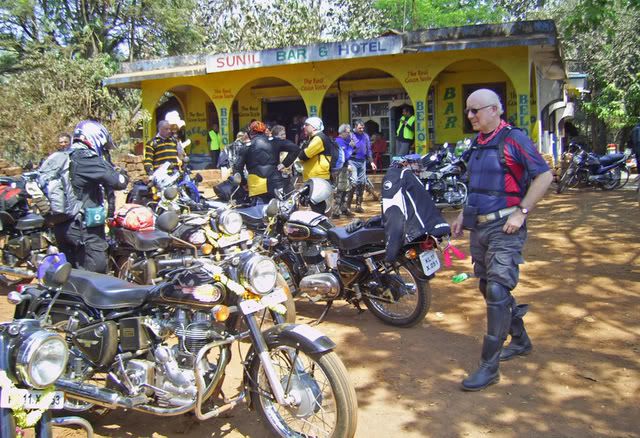
The Sunil Bar and Hotel. (In India a hotel does not necessarily offer accommodation.)
I kept meeting the guys in black and yellow. They came to India from Cornwall as a group.
The inside of the shop was deep in shadow and felt pleasantly cool. To the right of the entrance stood a wobbly drinks dispenser. To the left was a short counter. Further inside, an ancient and very hacked-about wooden cabinet with a glass front stood at an angle to the wall. Apart from a couple of stools and boxes scattered about on the concrete floor, there was nothing else. The cabinet contained a few packets of biscuits, one or two other indeterminate food items and some bottles of fizzy drink.
It took a few moments for my eyes to adapt to the gloom, but as they did, I began to realize that the shop could not have been seriously cleaned out for at least twenty years. It was filthy. Though, to be fair, there was probably little point in trying to keep it clean with all the sand and dust that must have blown in every day off the road. India is a very dusty place, I'm beginning to realise. The glass in the cabinet had been smashed - long ago, but the look of it. But some large lethal-looking shards remained in place, projecting from the bottom of the frame. The surviving glass fragments were so dirty that it was difficult to see through them.
I asked for a lemonade – not without a certain hesitancy. One of the young guys in the shop came out to the front of the cabinet, reached in over the shards of glass, retrieved a bottle and handed it to me. The bottom of the bottle was caked with grime. But the lemonade tasted good - very sweet. Indians tend to have a very sweet tooth.
I didn’t have a straw so I had to put a few drops of concentrated grapefruit seed oil in the bottle. I wiped the top with some more. I use grapefruit seed oil a lot if I go abroad and am not sure of the drinking water. It is a very powerful anti-bacterial, anti-viral and anti-parasitical agent. After sharpening up my hygiene awareness at the Sunil Bar, I used it in all cold drinks (apart from alcoholic ones) while I was in India. This meant that for two weeks almost everything I drank tasted of citrus.
Because Westerners have bodies that are wholly undefended against most Indian bugs I had already decided to be particularly careful on this holiday. I didn't want to spoil my time here by coming down with Delhi Belly. And my immune system was more unprepared than most. Like many people who have a professional background in complementary healthcare I don’t have vaccinations when I go abroad. (I’ve read the reports; I know what is in them; I know what the side-effects are; I know what they do to the immune system and I know just how effective they often aren’t!) Instead, I had a trusted kit of non-pharmacological remedies with me. They are very effective, but I have to take them several times a day, which can be a bit difficult if you are out in India on a bike. Nevertheless, they served me well. In two weeks, while everyone else was coming down with queasy stomachs, I breezed through without the slightest problem.
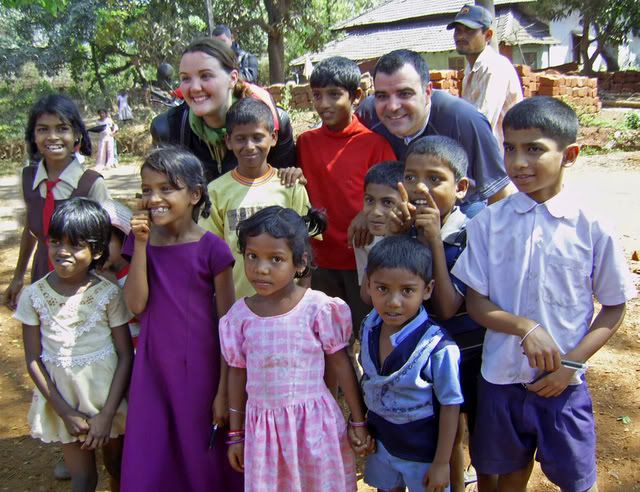
Indian kids are great fun but must be a nightmare to their parents
Some kids from the village had got wind of the fact that there were Westerners about, so it wasn't long before we were surrounded by a collection of small hands and smiling faces. Indian kids are extremely friendly. When you first meet them they are often very polite and disciplined. But that is just on the surface. Underneath they are pretty wild and uninhibited. One of the Enduro team, Ross arrived and started to ‘hand out’ ballpoint pens. (That’s him in the photo - the guy with the pink beard.) He started off sucessfully enough by getting all the kids to line up. But the moment the pens appeared it was a free-for-all scramble. As soon as he pulled a handful of pens out his tank bag these charmingly courteous youngsters suddenly started to resemble a pack of crockadiles in a feeding frenzy. No holds were barred.
But their honesty is equally apparent. Put your hand in your bag to pull out some pens and you will find a dozen tiny hands in there with you scrabbling around to see what they can find. Pull out your hand and they will remove theirs also. It seems that there is no intention to steal. They wouldn't do that. Whenever something is on offer, they just want to get to it first before someone else does. This is competition red in tooth and claw. From everything I've read this competitiveness runs very deep in Indian culture. Offer a polite group of kids sweets, and their sudden determination not to be left out will leave you in a state of shock and bewilderment.

"Little ß@$τ@Þ₫s." And this guy is a teacher in real life.
Beyond the Sunil Bar the roads turned tarmac again and the remaining 40 kilometres up in the mountains were a wonderful, lazy ride among scrubby deciduous forest and acres of terraced hillsides. They were lovely roads and the Enfield ate them up. They wound and dipped, ran in and out, up and down, among the tightly folded hills. Then finally, we rolled back down the mountainsides, through the towns of Goadongrem and Cancona, back into palm-tree country and on towards the coast.
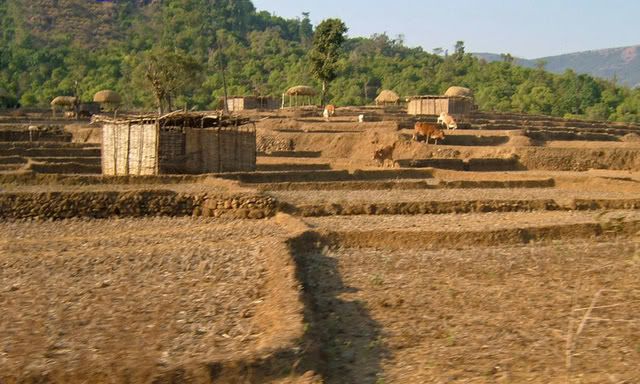
Terraced hillsides up in the Ghat Mountains. It's too high here for palm trees to flourish.
Somewhere along this last stretch I lost Larry. Suddenly, he wasn’t there with me any more. I rode back to find him, but he wasn't there. I raced forward but he wasn't there either. I told one of the team leaders whom I met, and he said he would look out for him but not to worry too much. There were plenty of riders behind me and up ahead. He would be able to hook up with someone. Eventually, and rather guiltily I gave up.

Wherever you stop in India, kids will gather round you and demand to be given pens. These kids lived in the
tentlike structures made out of of palm leaves in the background.
I attached myself instead to a group of Cornish riders I had met for the first time at the Sunil Bar. There were about six of them. They had come over to India together and rode as a group for the whole two weeks. They were unmistakable in their yellow and black, wasp-striped or chequered rugby shirts. I enjoyed travelling with them. They rode close to my top skill level and that kept me focussed and enjoying the bike. It was a great twisty ride (like so many) on narrow country roads that bucked up and down among the hills. Low shrubby trees were all that grew in the hedgerows at this altitude. The landscape was strangely reminiscent of Northrn England.
After sticking with them for about half-an-hour, though, the old feeling of wanting to slow down and look about a bit came over me again, so I lost them too. I finished the day on my own dawdling along and taking dozens of photographs. Despite the disapproval of The Team I began riding alone more and more as the days wore on.
For the last dozen or so kilometres the road made its way back towards the coast, dropping steeply downwards through a dramatic rocky landscape. The afternoon sun lit up the great bastions of rock on either side or threw them into shade. It was pure magic. It put me in a dreamy mood and the ride flowed. I could have gone on riding like that for ever. But nothing lasts. Eventually the road levelled out, and plunged back into the low-lying palm forest once again. I made my way by local roads, dusty and blown with sand, over to Palolem Beach and parked up my bike with the others among the beach huts. It was about four o’clock
I hadn’t realized how tired I was until I arrived and got off the bike. I hadn’t realized how hungry I was either.
Providentially, right opposite my hut among the palm trees, on the edge of the beach, was an open-air restaurant. I quickly dumped my gear in the hut, said hello to Brian, who was already there, and went over to inspect what the eatery had on offer. The evening meal provided by EnduroIndia wouldn't be for another four hours so I was in no mood to wait. I found the menu and ordered enough food to keep an elephant going for several weeks, and set about it with fine energy. It was great. With one notable exception, it was the best meal I had on the whole trip. Larry rolled up a short while later, safe and sound. It turned out that I had just run ahead of him. Whoops! Mustn't get carried away like that! Neither of us could work out why we weren't able to find each other again, though. I chatted with him in the restaurant for a bit and then went over to my hut for a shower.
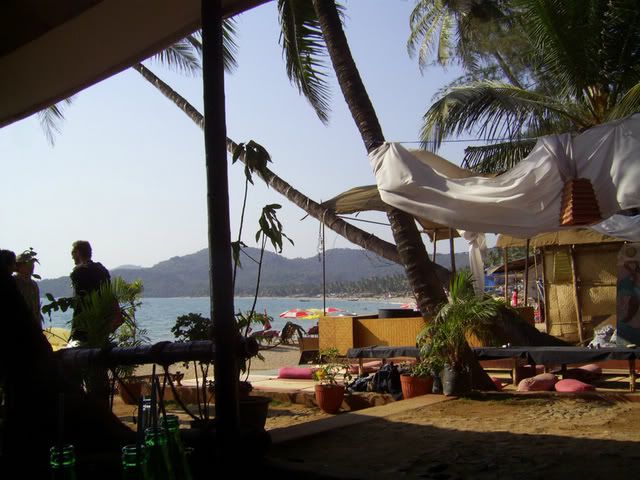
Palolem Beach. My hut is on the right. The open-air restaurant is on the left. The space in the middle
is reserved for those that hire hubbly-bubblies in the evening.
The hut stood on stilts and was built from large panels of old plywood as far as I could see. The floor creaked alarmingly as I walked across it. It had two bedrooms and a 'bathroom'. The shower was a miracle of ingenuity. It consisted of a tap high on the ‘bathroom’ wall. The tap was fitted with a rose to spread the water. There was no plug hole to let the water out, just a gap between the slightly sloping floor and the wall. The sandy ground a couple of feet below was a sufficient soakaway. It wasn’t the hottest or most comfortable shower I have ever had but it was most welcome.
“Very rough accommodation” the EnduroIndia Roadbook had called our beach huts. ‘Rough’ is fine by me. Now that I'm in my middle-age, I’ve grudgingly come to appreciate the advantages of staying in hotels, but this sort of set-up is a lot more fun. I like to feel part of the landscape when I'm on holiday. Staying in a westernised hotel when you are abroad defeats the object, somehow. It puts up a barrier between you and the real world outside. I was glad I had brought my sleeping bag with me, though - Brian and I were apparently sharing a bed. You’ve got to hand it to the EnduroIndia team – no austerity was spared. The less it cost them to accommodate us, the more money they could give to the charities they sponsored and we had raised money for. That was fine by me, too. Behind the partition in the other half of the hut were Peter and David, identical twins. I got to know them a lot better a few days later but I never did learn to tell them apart.
Palolem beach is several miles long: a smooth arc of palm-fringed sand running down to the Arabian Gulf. Tucked away among the palms that fringed its entire length were thousands of beech huts, looking as though they had grown there among the trees. Facing the sea were dozens of beach restaurants, bars and kiosks selling holiday ware. The hut I was sharing was great. It faced directly onto the beach. But as there were no windows we couldn't enjoy of the view. Shame!
As everyone piled down onto the beach we got the news of the day's events. There had been some problems with dehydration. That was a real and constant threat. You have to remember to drink regularly in this heat - every fifteen minutes or so. Absolutely essential! We had all brought a Camelback-type water carriers (a compulsory part of the kit) but it was still easy to forget. The Camelback is a narrow backpack containing a water sack. You can wear this comfortably over your armour. It had a drinking tube which comes over your shoulder and clips onto the strap. With this kit you can drink regularly without having to stop or get off the bike. Only trouble is, out on the Indian roads, the tube gets very dusty and every first mouthful tastes just a bit yearrgh!
One group of riders reported some interesting encounters with livestock out on the roads today. They narrowly missed several large domestic mammals (including a cow - whoops!) and managed to kill a chicken. I didn't hear what the outcome was. Incidents like this can turn nasty in India, and the Crew had advised us, for small animals, just to ride on. For encounters with larger animals or people we needed to get the Organisers on the spot quickly. People involved in accidents have been literally lynched before now by angry mobs. 'Justice' here can be very local. I heard of one decking. A rider had skidded on a gravelly corner and gone down and his riding mate had run over his leg. There were no broken bones.
In previous years everyone had travelled over to a small offshore island in boats and eaten supper on the beach. It sounded idyllic. This year it didn't happen, though. The local boatmen, who used to take the Enduros out to the island in groups of twelve were suddenly saying they couldn't do it any more. There was a new regulation, they said, which forbade them from taking more than six in a boat. The general consensus among the Enduro Team was that this was bullshit. Their view was that the boatmen had seen an opportunity to double their income and had come up with this story. But it didn't do them any good. There was a change of plan. It would have taken much too long to ferry everyone out in small groups like this, so the team had hurriedly made other arrangements. We were going to eat at what was, by all accounts, the top Palolem eatery, only a couple of hundred yards down the beach from where we were staying.
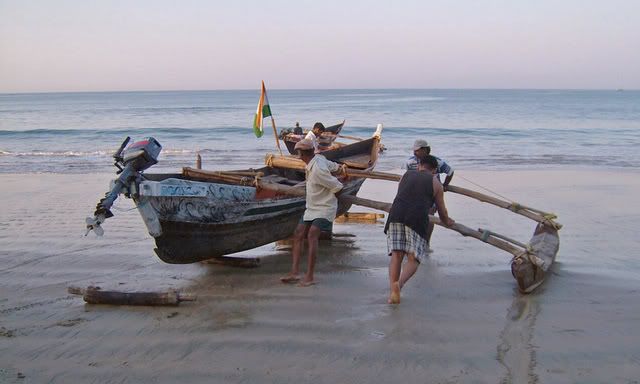
The boat we never took to the island we never found
At about ten to eight, as the light was fading, I began to make my way over to the restaurant for supper. The atmosphere on the beach was amazing. I don't generally like tourist resorts much, and I'm not so keen on beaches, but I can see why people come here. It is just so laid back. I'd met up with Justin, one of the EnduroIndia Team, as I was walking, and started talking to him when a figure came running up behind and stopped us. It was Mary, still wearing her off-road armour. She and five others had just got in. She was laughing but exhausted. The group had taken a wrong turning near the goods yard, and had ended up totally lost in the middle of nowhere. At least half the team were still out trying to find them. No-one had ever got that lost before, Justin said, not on this stretch.
While Justin and Mary were laughing about the situation, a huge cloud of mosquitoes swept along the beach. I couldn’t see them in the evening twilight but I could feel them. There were so many that their wings felt like a single piece of soft cloth flapping about my face and neck. Southern Goa has a very low malaria risk, but it's not negligible and I had forgotten to dose myself up with Vit B1 that evening or use the insect repellent spray. I turned back to the hut to get them.
As it turned out they probably weren’t mosquitoes at all. Though what they were no-one was quite sure. Some said that they were flying ants, others that they were sand fleas. (I didn't think that sand fleas had a flying phase, but who knows?) Whatever they were, there were billions of them. They swarmed up the beach for about half an hour and then just as suddenly disappeared.
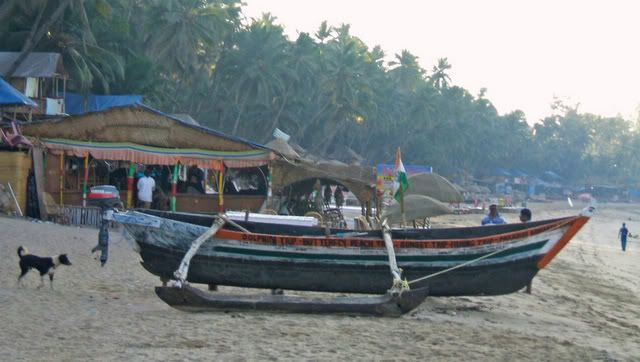
Palolem beach with its fringe of palms, beach huts and hot nightspots
The evening meal at the restaurant was good, but there was so much of it and so much choice! It was all put out in huge steel basins for us to serve ourselves. The basisn stood on a long line of tables that stretched for about twenty yards along the beach. There were fish and meat dishes, vegetarian dishes, dhals and curries, bhajis of all sorts, rice and poppadoms and naans and chapattis, sauces and soups and salads - and loads of other things I couldn’t identify then and can’t remember now. It was a feast. The highlight of the meal, though, was the fresh catch of king prawns. These were monsters. I’ve never seen prawns like them. They were so amazing I thought they merited a photograph all of their own.
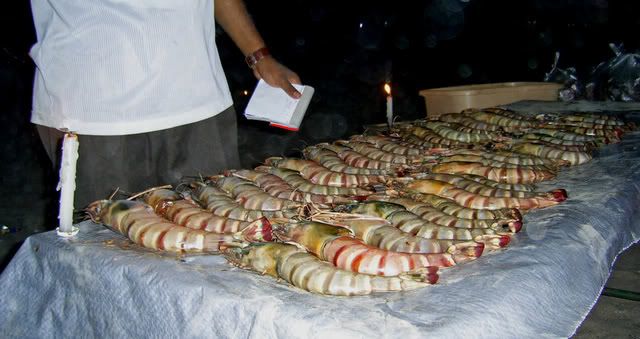
King prawns laid out for our beach feast
We ate at a double arc of tables spread out along the beach, all lit with hundreds of candles. And above us was a brilliant starlit sky. Near the tables someone had started a fire of crackling driftwood. The warmth came drifting across to me. We talked, and ate and listened to the sound of the surf, while the warm coastal breeze blew over us and fluttered the candles. And for two hours I stuffed myself silly again (for a skinny guy, I have an enormous appetite) and downed serveral bottles of Kingfisher lager. I had promised myself no more alcohol on this trip, but on a night like this, who could resist. I couldn't. People moved around between helpings and courses and I started to get to know the group a little better.
We came from a wide variety of backgrounds, but the majority, I'd say were professionals or small businessmen. That was only to be expected I realised later. The EnduroIndia deal is that you pay £500 towards the cost of the rally and then you raise an additional £3,350 for charity. To raise that amount of money you have to have a lot of time and resources (or, in my case, a lot of generous and helpful friends), so I guess it would tend to attract people who have both.
At the table I talked to a bloke who was a Triumph dealer in the Midlands and to a reporter who worked for one of the broadsheet national newspapers. There were hoteliers and bank clerk among us, mechanics and entrepreneurs, and professionals of all sorts. I met up with Pip again. In the course of our conversation it emerged that Pip lived in Stevenage (where I work!). I also talked with David for the first time. David was one-half of the crazy, madcap David and Toby combo of which much more later. These two were seriously crazed, and very entertaining.
We got our head down early that night. Or at least I did, though there was a strong core of hard-drinking party animals among us who stayed up till the small hours of the morning. And they carried on the tradition right throughout the trip. Among them were most of the EnduroIndia Team. I am seriously impressed at how much alcohol these guys could put away and still ride a bike the following morning. They seemed to function well on it too. I’ve never had that kind of stamina.
As I dropped off to sleep I found myself wondering how Pip’s new room-mate was faring with that incredible ear-bashing. I slept well, but a lot of people didn’t. Palolem Beach is inhabited not only by hoards of partying humans but also by large packs of stray dogs who fight and bark all night long. I was vaguely aware of their howling as I dropped off. Brian woke up early next morning looking even blearier than ever.

Last edited by sv-wolf on Sun May 27, 2007 12:42 am, edited 3 times in total.
Hud
“Man has no right to kill his brother. It is no excuse that he does so in uniform: he only adds the infamy of servitude to the crime of murder.”
Percy Bysshe Shelley
SV-Wolf's Bike Blog
“Man has no right to kill his brother. It is no excuse that he does so in uniform: he only adds the infamy of servitude to the crime of murder.”
Percy Bysshe Shelley
SV-Wolf's Bike Blog
- sv-wolf
- Site Supporter - Platinum

- Posts: 2278
- Joined: Sat Dec 13, 2003 2:06 am
- Real Name: Richard
- Sex: Male
- Years Riding: 12
- My Motorcycle: Honda Fireblade, 2004: Suzuki DR650, 201
- Location: Hertfordshire, UK
Getting the next post up soon. In the meantime, here's some vids that other guys did on the trip this year. Try them out.
http://youtube.com/watch?v=02NdW85heY8
http://www.youtube.com/watch?v=AqrOpNHR2uM
http://www.uvouch.com/video-Enduro-India-2007-401718
http://youtube.com/watch?v=BWyoGD-ZD00& ... ed&search=
http://youtube.com/watch?v=Gon0VEOJWVs& ... ed&search=
http://youtube.com/watch?v=Gon0VEOJWVs& ... ed&search=
http://youtube.com/watch?v=fLc4KB5EZgk& ... ed&search=
http://youtube.com/watch?v=Tc9rK65yK8c& ... ed&search=
http://youtube.com/watch?v=h-sO4gcIgLE& ... ed&search=
http://youtube.com/watch?v=yfQl1wqqxq0& ... ed&search=
http://youtube.com/watch?v=DH28nR7-JTY& ... ed&search=
http://youtube.com/watch?v=02NdW85heY8
http://www.youtube.com/watch?v=AqrOpNHR2uM
http://www.uvouch.com/video-Enduro-India-2007-401718
http://youtube.com/watch?v=BWyoGD-ZD00& ... ed&search=
http://youtube.com/watch?v=Gon0VEOJWVs& ... ed&search=
http://youtube.com/watch?v=Gon0VEOJWVs& ... ed&search=
http://youtube.com/watch?v=fLc4KB5EZgk& ... ed&search=
http://youtube.com/watch?v=Tc9rK65yK8c& ... ed&search=
http://youtube.com/watch?v=h-sO4gcIgLE& ... ed&search=
http://youtube.com/watch?v=yfQl1wqqxq0& ... ed&search=
http://youtube.com/watch?v=DH28nR7-JTY& ... ed&search=
Last edited by sv-wolf on Tue May 22, 2007 8:59 pm, edited 3 times in total.
Hud
“Man has no right to kill his brother. It is no excuse that he does so in uniform: he only adds the infamy of servitude to the crime of murder.”
Percy Bysshe Shelley
SV-Wolf's Bike Blog
“Man has no right to kill his brother. It is no excuse that he does so in uniform: he only adds the infamy of servitude to the crime of murder.”
Percy Bysshe Shelley
SV-Wolf's Bike Blog
- NightNurse
- Legendary 300

- Posts: 353
- Joined: Sun Apr 01, 2007 12:46 pm
- sv-wolf
- Site Supporter - Platinum

- Posts: 2278
- Joined: Sat Dec 13, 2003 2:06 am
- Real Name: Richard
- Sex: Male
- Years Riding: 12
- My Motorcycle: Honda Fireblade, 2004: Suzuki DR650, 201
- Location: Hertfordshire, UK

22nd Feb
Day 2 of the Rally
Start: Beach Huts on Palolem Beach (Goa)
Finish: Om Beach at Gokarna
Distance: 210 km.
“The second day is longer and more demanding but feels no harder due to the fact you are becoming more confident on your bike and the forest trails and mountain passes are becoming less daunting. Today’s ride is quite simply mind-blowing as we wind our way on and off road all the way over the mountains and back to our night’s stop point at a truly secret cove, looking out to the Arabian see. Tonight the accommodation is packed tight and hot.”
From The EnduroIndia Roadbook 2007
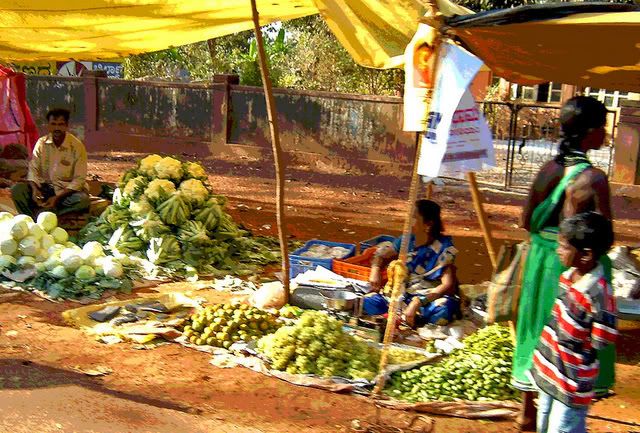
I said goodbye to my hut (I’m a sentimental soul), turned my back on the lazy life of Palolem Beach and headed off into the palm forest to find ‘Beast’ (that’s ‘Beast’ as in, ‘Beauty and the Beast’) - my bike, my Royal Enfield Bullet and began to think about the day ahead.
I was looking forward to today's ride. This was going to be the first big ‘off-roading’ day of the rally – and the first time I had done any ‘off-roading’ of any kind. The idea of riding forest tracks in India sounded to me like heaven, one big adventure wrapped up in another. I have to admit that there was a nervous tremor in my belly as I walked out towards the bikes that morning. But like all other feelings and thoughts it was being swamped out by a flood of excitement.
‘Off-roading’ is what everyone was calling it but in fact, we were going to be riding on 'roads' all day today. It's just that, like everything else in this amazing country, the definition of a ‘road’ is very broad. It is applied equally to a National Highway and to the strip of semi-passable ground we would be taking through the hillside forests near Bare (pronounced Bar-ray).
Once, long ago, this ribbon of sandy soil had been a proper road, with a proper surface to it, but no-one had travelled it, except on foot, since the time of the British Raj – not until the EnduroIndia Crew discovered it and got permission to open it up again. Simon included it in the route for the first time last year. It had taken The Crew four years to get it into a rideable state. And even after all their work, it is still no more than a rough track.
I had no idea how well I was going to manage to ride on this sort of surface - I'm the guy who gets nervous riding over his mate's gravel drive. But I reckoned I’d soon find out. I was up for a challenge, and off-roading sounded like fun. Many years ago I discovered an important principle: if I wanted to do something badly enough, there was no point thinking about it. I just had to get out there and stand on the starting line. Once I had got that far, I was unlikely to turn back. And doing it that way, I enjoyed the experience all the more for not having a head full of pre-conceptions about it. I'm cautious (and lazy) by nature and if I hadn't learned that bit of wisdom early on, I'd have led a much duller life.
The way the Enfield had coped with the dusty lane the previous day had given an extra boost to my confidence and I was looking forward to something meatier. I wanted to have a few emotional highs on this trip and I was expecting this to be one of them.

People finished wolfing down their breakfasts in the beach cafe and assembled by the bikes. Simon called for hush and everyone gathered round The Crew (sort of) for the morning ‘briefing,’ which, because it was delivered by Simon, wasn't all that brief - but it was entertaining. Over the next ten minutes we got the usual advice about not travelling alone (
It was during this morning’s meeting that Toby first came to everyone’s attention by winning the ‘Dick of the Day’ award. It was inevitable, like a law of nature. Toby, with his tangential take on life was simply wired up to get himself into a pickle. By the end of the rally, then, no-one was surprised that he had won the award several times.
He had come out to join the rally with his mate, David. Toby and David quickly emerged as two of the ‘characters’ on this year's rally, a spectacularly entertaining double act who were rarely off everyone else's radar. Love 'em or hate 'em, you couldn't ignore them. In the coming weeks, their experimental approach to almost everything livened up the days’ riding and provided much of the evenings’ entertainment.
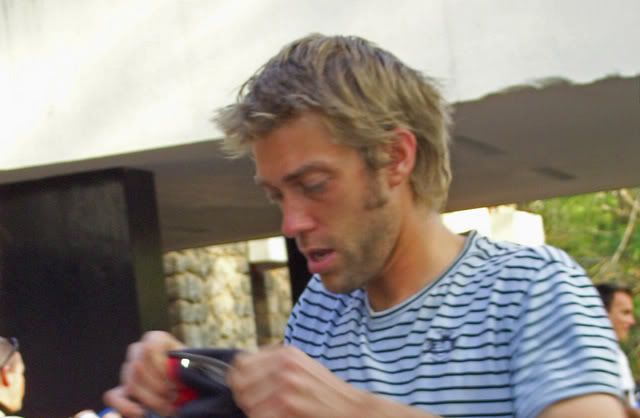
Toby
Simon had overheard a conversation the previous night through the thin plywood walls which divided the beach huts. In the neighbouring hut David and Toby were almost helpless with laughter as they talked over the day's events. Toby had brought his sleeping bag to Palolem on the bike with him, as we all had. It was a bulky, old-fashioned looking bit of kit, which he had bought at the last minute. It had taken up a lot of his luggage allowance on the flight and, yesterday, had been a nightmare to get here because it kept falling off his bike. (David had carried it for a while, and it kept falling off his bike, too.) Last night, Toby had unrolled his sleeping bag for the first time, to discover, much to his surprise, that it looked less like a sleeping bag and rather more like a blow-up rubber dinghy.
After the briefing, people went back to their bikes and kicked them into life for the day’s ride. A beautiful and very distinctive roar began to reverberate through the palm forest. Listening to the sound of one-hundred-and-fifty of these elegant little machines rumbling in unison was enough to put a zing in anyone’s blood. I stood there loving everything about this trip so far. And especially the sturdy little Enfields – though they weren't quite so ‘little’ in my imagination any more, now that I'd had time to discover what brilliant machines they were. I looked around for Larry, but he was parked much further back. I would have to wait for him once I got out onto the road. But for now I nudged forward to get a better placing for an early start, and wedged myself in among those close up to ‘poll position’ (competitive? Me?) .
While I waited for the off, I glanced back through the trees to see if I could catch a last sight of my hut and the long line of the beach. I wanted to fix the scene in my memory. I’d really fallen for this place. I could see myself coming back here some time in the future and chilling out. As it turned out, I wouldn't have to wait very long to see my hut or Palolem Beach again. Three weeks later, back in England I was watching the opening sequence of the latest James Bond film - and there it was: my hut! large as life, snuggled up against the edge of the trees, with JB racing past it in full pursuit of someone or something.
One of the crew members was suddenly pointing and waving his arms. I had no idea what was going on. The bikes in front of me started to move over to one side or another, leaving me a clear line onto the track ahead. Nothing was coming up from behind. I hung back for a few seconds then, in a moment of impulse or impatience, went for it, kicking the Bullet into gear and riding down the quarter mile of sandy, winding paths among the beach huts and shacks to the main road. At the road, I looked back. Nothing. No-one had followed. I was alone. Whoops! So I parked up, and chatted to the film crew positioned near the gates and waited with them for the 'grand exit of bikes' - which didn’t happen for another ten minutes. It was the first and only time on the rally that I was anywhere near the front.
I slowed to let others ride past till Larry came by and then set off with him at a fair pace down the narrow country roads. Houses and people crowded in on us thickly. India is densely populated and coastal Goa is no exception. Villages followed one another with hardly a break between them along the roads. On either side of us locals were coming and going, walking up and down. Children, togged up in immaculate uniforms, were making their way to school. Small family houses were interespresed with very impressive looking villas or recently built blocks of flats. It was all very dusty and, in places, a bit thrown together; the roads were cracked and potholed but Goa has the smell of modest propsperity about it. So far I'd seen nothing approaching the extreme poverty you see in Oxfam adverts.
I hadn't ridden far through all this buzzing human activity, when I met the front riders coming back towards me. I never did find out for sure what the road blockage was up ahead of us, but it meant a detour. I turned back and followed the rest. The detour was no big deal in itself - just a matter of a few kilometres - but it totally screwed up my maths for the rest of the day. ‘Beast’ had started out that morning with exactly 2,350 km on the clock. This made calculating distances from our starting point very easy - which was all to the good as I had a mild hangover that morning and I am totally incapable of adding up when I have a hangover. The detour meant that I had to recalibrate. My effective starting figure when working out distances on the route map was now 2,357.4 km. But 2,357.4 km is not so easy a figure to calculate with - or even bloody well remember. Damn! Until the Kingfisher-induced fug wore off that afternoon, I was going to have extreme difficulty in working out where I was.
Twenty km out from the hotel, we passed a petrol station, and to judge from the number of riders who had pulled into its forecourt, it seemed that most of us had forgotten to fill up the night before. I had a fairly full tank but I wanted to check my tyre pressures, so I decided to find the air pump and thought I might as well top up with petrol at the same time.
The owner of the filling station had a gleeful and slightly mad look in his eyes - as well he might. He was running back and forth between the office and the pumps carrying wads of notes. He was having a good day. There were four pumps on the forecourt but there were only two attendants and it seems it takes two attendants to fill a single bike in India. The queue moved slowly, but as always, it was a lovely morning, and no-one but the front runners felt in much of a hurry - and the front-runners were long gone.
The youngsters operating the pump made a great thing of pointing out to us that the gauge read ‘0’ before they started filling the engine. Clearly they were familiar with the Western belief in the wholly dishonest nature of all ‘foreigners’. But the task of filling our tanks was carried out quietly and smoothly. When it came to pumping up my front tyre it was a different matter. The queue for the air pump was not so long, but inflating tyres was clearly a more complex process. It took four grown men and a lot of shouting and waving of arms to ensure that my tyre was correctly inflated. In a country with vast levels of unemployment, you often find this kind of ‘job-sharing.' Wages might be low but at least everyone has something to take home to the family at the end of the working day.
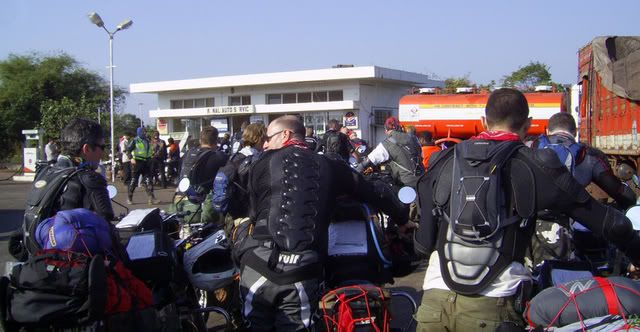
A long wait at the Oil India petrol station. You get the impression that most Indians
do not understand the meaning of a word like 'hurry.' The guy in the balaclava near the lampost
is Andrew, one of the doctors. At home he volunteers as a speedway medic.
Another six kilometres up the road we ran into the border check post. We were about the leave the tiny tourist state of Goa and enter Karnataka - ‘Real India’ as someone described it. Goa is relatively europeanised and the lack of serious poverty has a lot to do with the tourist trade. I was told that once we crossed over the border, that would change.
The check post was no more than an informal barrier across the road - permanently raised - with a sleepy attendant in military uniform standing beside it. It was there just to make a point rather than stop the traffic. What I wasn’t expecting was the reception committee on the other side.
About twelve guys in formal business wear – immaculately pressed striped shirts and well-creased trousers - were standing in a row, supporting the poles of a huge banner. Several others were holding up a smaller banner at waist height. Both banners read, “Welcome to Karnataka.” As each car or bike passed through the barrier a portly chap with a mature beer gut stepped forward, wreathed in smiles. “Welcome to Karnataka, sir,” he would say, repeating the mantra for what was, no doubt, the umpteenth time that day. And as he made his greeting, he presented the driver or rider with a single red rose. Like Larry and Hash and most of the other Enduros, I had bike gloves on. So, with the most meticulous care, the guy leaned over and attached the rose to my armour, before standing back and waving me on.
My guess is that he and his fellows were members of the Karnataka state tourism board. We came across a number of such worthies in the different states we visited. I was very tickled by this greeting. It was just so… Indian! I tried to imagine a reception committee of Round Table small-time businessmen waiting for me with a budding rose as I crossed the county border between Hertfordshire and Bedfordshire back home in England. “Welcome to Bedfordshire, sir," they might say ("Enter our beautiful county and spend lots of money.") No. No way! It wouldn't happen like that. The most you might find would be a couple of locals leaning over their fences shouting, “Bloody bikers; bugger off back where you came from.” That would be more like it.

I was in a very happy mood as we rolled down the wide open highway beyond the barrier. Larry, and I were riding at a lazy 45 km per hour. We crossed a bridge over another broad, palm-fringed river, took a sharp 300 degree turn, rode along beside a canal then ticked along down a tiny tarmac road at 10 miles an hour. The road ran right through the neat and tidy village of Idgundi. It was so narrow I was sure I was going to hit something - or someone. We squeezed our way past old men and sacred cows, sleeping dogs and excited children. Small inconsequential details took on a strange significance and lodged themselves in my memory: a busy, staggered junction; an old man with a stiff leg; a tumble-down grocery shop; two women in a telephone hut; the vivid blue of a wall; the doleful eye of a cow as it ambled past. All these details flashed brilliantly for a second into my consciousness before melting away into memory. They seemed no more than expressions of the bright, sunlit world around me, part of my happy mood. A bit of me wanted to stop the bike, to talk to people, to move closer to their lives and to the things that they made their lives out of, but the rest of me carried on riding. I knew that if I stopped, even for a second, and engaged my mind with detail, the spell would be broken and my blissful but delicate mood would be shattered for good.
Detail aplenty broke in on my thoughts at the next turning which took us back (briefly) onto a busy road and demanded total concentration. The world changed abruptly. The flow was gone, but my happiness remained. We followed some lovely twists and turns on a beautifully cambered road that swung gracefully downhill, through sparse and delicate woodland.
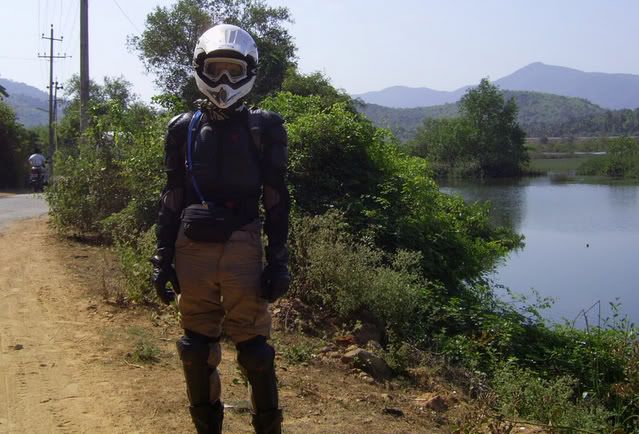
Well I've got to fess up to this one. I've never carried much weight, but I lost a lot more in India
thanks to having to eat a lot of things I am allergic to. It happens every time I go abroad. So this is me
looking like a 15 year old boy.
The world changed again, and we were riding on narrow, poorly surfaced country lanes sweeping along among grassy levels and bits of scrubland. A broad river came into view, and flowed beside us, almost lapping the road. Here and there it briefly turned away or widened into empty marshland. We stopped among a lonely, watery landscape to look about us and take some photographs. A solitary woman in a brilliant red and yellow sari crossed a distant causeway among the river channels. And around her - flowing water, open sky, a little solid earth and the infinitely mournful cries of river birds.
Further up the road another Enduro had stopped and was gazing silently at the view. We said, hello, and he asked me to take a photograph of him against the watery background. His name was Hasham. I hadn’t met him before. He told me he was Indian by birth but had lived in Northern England almost all his life. We stood together for a long while drinking in the scenery. Before we set off again, Hash asked if he could ride with us. We said yes, of course. Then we stayed together till the end of the rally.

A few kilometres further on, we stopped again by a huge temple standing in the middle of a field. And again by another distant river. Other riders stopped too or passed on by. Some stood up on their pegs to catch the view, or waved as they passed. Apart from the occasional Enduro and a few people on foot going to and from the fields, we were alone on this silent country road.
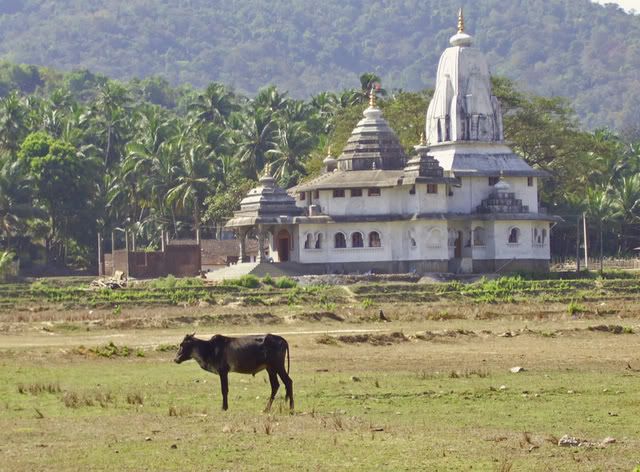
It was while we were standing, wathcing the waters of the river slowly sliding by that we had our first encountner with Ali and the camera to which she was firmly attached. Ali was a kind of ‘unofficial photographer’ to the rally. She hitched pillion rides from the Enduros all along the route, stopping off here and there to photograph the scenery or the bikes and riders. She had got herself dropped off by the river so that she could capture the view and was now waiting by the side of the road to pick up another lift. She rode with me for a while, snapping away as we went.

Hash and Larry
Twenty kilometres further on and the world changed once more. We were back on broader and busier roads but still among wild country. We stopped for a break and a drink at a wayside stall. Several Enduros were already hanging about drinking tea when we arrived. Larry, Hash and I dismounted, stretched our legs and discretely wriggled our bums. I was already beginning to experience the first symptoms of Monkey Butt, that well-known by-product of riding a Royal Enfield Motorcycle. Monkey Butt isn’t pain as such, just an unpleasant creeping numbness and the uncomfortable impression that your gluteus muscles had taken on the qualities of shrink wrap. “Built like a Gun” had been the motto of the British Enfield Motorcycle company. “Hard as a Bullet” might have been just as appropriate. It was a tough little bike with an even tougher saddle (for which, read ‘plank’).
I didn’t want tea myself. Indian tea is brewed in a large container with milk and an industrial quantity of sugar already thrown in. For someone with a biochemistry like mine, Indian tea approaches the condition of a poisonous substance. I wandered about taking in a few details and feeling a little vague from this morning’s ridiculously early getting-up time and several hours of magnificent but highly focussed riding. There wasn’t much to see. Two painfully thin dogs were pawing over a large pile of vegetable leftovers by the side of the road. Several women were walking up and down attempting to sell garlands of flowers to parked motorists and Enduros. Larry and Hash were deep in conversation. I needed to take a leak. (Now stay with me on this one. It’s educational! If you are walking, camping, cycling or motorcycling in any foreign country, you need to know what the acceptable public behaviour is in the bowel and bladder departments.)
Behind the stalls was a steep, tree-covered slope which dropped away to the village in the valley below. Rising up the slope was a dirt track - an oddly busy little track since, at this end it ended in almost nothing (apparently): just the stalls, the road and miles of rough hill country as far as the eye could see. I found my way down among squat trees and bushes for about twenty yards, hoped no-one was coming and began to battle with all those bloody zips and press studs.
I was already half way through the business when I realised I was not alone. Two women with the same idea, were squatting in the bushes nearby. Now, I have no personal modesty in matters of this kind; I could quite happily dispense with most of the social rules around toilet behaviour, but it doesn’t do to go offending other people’s taboos and sensitivities for no good reason; so I carefully found a tree on the other side of the path and turned my back on the two women. This act of minimal politeness was met by great waves of giggling from the other side of the path. One of the women was Indian the other was an Enduro, but they were both helplessly amused at my behaviour. The giggling was followed by a mini-lecture from the Enduro on the ‘spiritual freedom’ of having a pee in the 21st century. (
The matter of appropriate toilet behaviour was settled for me soon after when an Amercian Enduro asked an Indian chap the whereabouts of the nearest toilet (or whatever euphemism an American would use for a public lavvy). The man looked puzzled for a moment and then, remembering he was in the presence of an alien being, flung wide his arms and replied in classical vein: “India, one very big toilet, sir.” Well, that was a relief! From that point on it was possible to get on with essential business, without unnecessary expeditions or gymnastics.
About nine kilometres further on we saw the junction we were looking for. We turned off the main road and immediately joined a throng of Enduros, Crew members, and an ambulance driver, all of whom were hanging about, taking a break before starting off on the next, very different leg of the journey. Nearby were two signs, one announcing the nearby presence of the Kaiga Power Generating Station ('No Entry') and another pointing in our direction saying simply, ‘Bare.’

This was it! This was the unmade road I had been looking forward to. The Enduro India Crew had really done a lot of work on it. As we stood about, glancing up at the steep, folded hillsides all around u, Simon told the tale of how they had found it. His story went like this. In their search for some really great rough-biking roads they had begun by ransacking the shelves of Indian Libraries. But large-scale road maps of India just do not exist and local roads are known only to local people. When they found no decent maps of any kind on library shelves, the Crew turned their attention to the universities. They contacted a number of academic departments until they found a professor of geography, who had some old Ordnance Survey Maps of India from the time of the British Raj. (One thing the British have always been very good at is making maps. It is practically an obsession. The old OS maps are some of the best ever made, anywhere).
With the help of the OS map, The Crew identified the old Bare Road as a possible candidate for what they wanted and went to take a look. It was perfect, they decided, but needed a lot of work to make it passable for bikes. When they first found it, it was thoroughly overgrown. To get through on that first occasion they had to lift their Enfields over fallen trees and hack their way through the undergrowth. They got permission from the Karnataka government to open it up. It took them several years to clear it and even now they still have to take chainsaws up there every year just before the ride.
It was briefly perfect, Simon said. Then things started to go wrong. As soon as the road had been cleared, the Karnataka government started to ‘improve’ it. At first The Crew tried to explain this was not what they intended, but then realised that the government was seizing the opportunity to turn it into an escape route for the nearby Kaiga nuclear power station in case of an accident. Not so reassuring! Simon laughed. “Nothing happens that fast in India and so far the improvements haven’t progressed very far. The road is still brilliant,” he said.

Riders began to power up. The ambulance driver got into his cab. I lingered for a moment to take a few more pics, then set off behind him. Big mistake!
For some several hundred yards the Bare Road ran along the open hillside, still reasonably surfaced. Then suddenly, as can happen even on conventional Indian roads, the tarmac ran out and was replaced by sandy soil and bare rock. The ‘road’ turned a corner and plunged into the dense hillside forest. The surface dust must have been a foot deep in places. This was totally unexpected. Yikes! I had some hairy moments in those first few minutes. I thought I was going to lose the bike at least a dozen times, and twice I was sure I was going plunge off the road and down the side of the hill into the trees. If anyone had seen my face during that time, it would have been worth a photograph. My pupils must have dilated with shock because everything suddenly went very bright. But again, the Enfield coped very well. It was far more planted and handled better than I could ever have hoped for. I didn’t go down; I didn’t go over the edge, and that began to give me a little confidence. Gradually, I recovered from the mire of panic that was drowning out my thoughts, and got control of my riding. I convinced myself that I was going to survive.
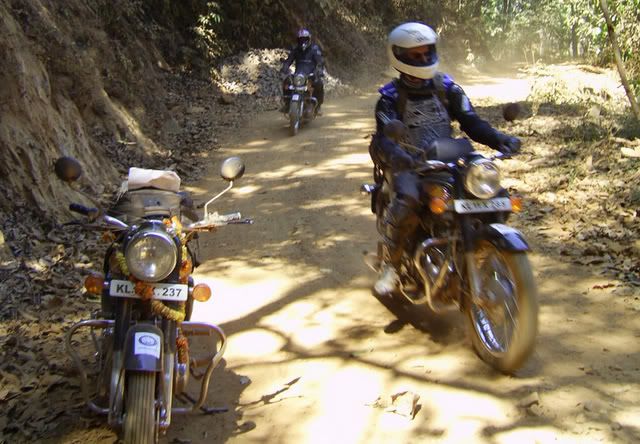
However, the track was not the kind of place to find yourself following close behind an ambulance, especially on a bike. I was riding into a total sandstorm thrown up by the vehicle's back wheels. I could see no more than a couple of inches in front of me. And I couldn’t overtake because the ambulance was occupying the whole width of the track. In any case, every physical and mental function I had available was still concentrating on staying upright. Overtaking would have required more presence of mind than I could muster just at that moment.
But I had to do something. If this goes on much longer, I thought, I’m going to finish the day travelling in this bloody ambulance as a passenger. The image of riding through all that dust for the next god-knows-how-many kilometres grew in my mind and became so vivid that suddenly something inside gave way.
I am usually fairly even tempered but I was now seriously p1ssed off. And there is nothing like being p1ssed off to help you get over inhibitions or anxieties. So the moment I saw the tiniest gap opening up between the ambulance and the edge of the road, I didn't think, I just did the Indian thing – I jammed my thumb onto the bike’s horn and dived into it. I had just enough space to stay on the road with my bar end occasionally scraping against the side of the vehicle.
Stupid? Foolhardy? I don’t know. But I got past the ambulance with a delicious sense of aggressive determination churning in my belly. And as I passed the cab, I was whooping at the top of my lungs. The driver was laughing and gave me a thumbs up. As soon as I was clear of the big lumbering four-wheeled thing behind me I rolled on the throttle and tore up the track. I’d passed some kind of psychological barrier, one that was to give me a different perspective on riding for the rest of the trip - and beyond. (Now, back in England, I realise my riding has taken a quantum leap forward and is freer and more confident than it ever was in the past. One moment. That's all it took.)
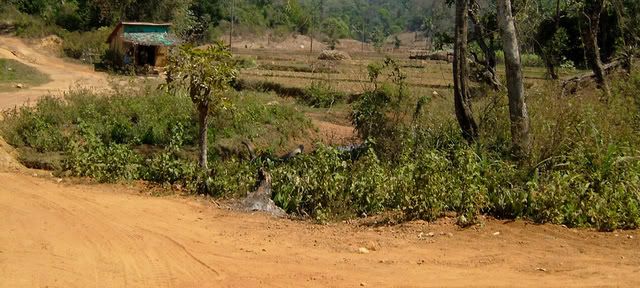
A sense of present reality did eventually penetrate my skull again and I slowed a little to make my way up the long track, past little waterfalls and over fording streams. The track markedly improved the higher it got, until it turned back to solid earth, strewn about with small stones. Down in the valley to my left, dumped bizarrely in the middle of the jungle, was the Kaiga nuclear power station. I got an occasional glimpse of it, but paid it little attention. The amount of energy that was being generated down there among the trees was nothing to the sheer adrenalin charge that was zinging away up here on the Bare Road.

I was still experiencing the tail-end of that adrenalin rush and feeling that I could tackle anything when suddenly up ahead the road surface changed again. When Simon had said that, “they were improving this road,” he didn’t mean it in a general sort of way, I suddenly realised; he meant literally that ‘road engineering works are taking place at this very moment as we speak.’ Overlying the dusty red soil, up ahead, were several hundred yards of newly laid hardcore: sharp hunks of broken stone up to four inches across, not yet pounded down and not yet settled into some sort of stability.
“You’ve got to be kidding!!!”
But no, this was for real. Adrenalin is amazing stuff. The manic glee of that first rush was now all but gone but the determination remained. I put my head down and hoped for the best. I just couldn’t have imagined myself doing that three days ago.
‘Looseish arms, even throttle, let the bike pick its way…’ I remembered the advice a friend had given me back home, and I did as I’d been advised. Once again I was surprised at how well the Enfield coped. Great bike! In the end it was me that funked out. About two-thirds of the way across, I fixated on the guys who were watching from far side of the stones (including Simon, who was laughing his b******s off) and suddenly I got all self-conscious. Immediately, I stalled the bike and then couldn’t kick it back into life. It took me about a minute to get the engine going again. And as I stood there, thumping away at the kick start, I was watching some of the other guys going by. The most successful ones, I noticed, kept the throttle open and took it all at a fair speed. OK, if that’s the way to do it… Well, it seemed to work. I cleared the hardcore and rode onto the bridge at its far end.
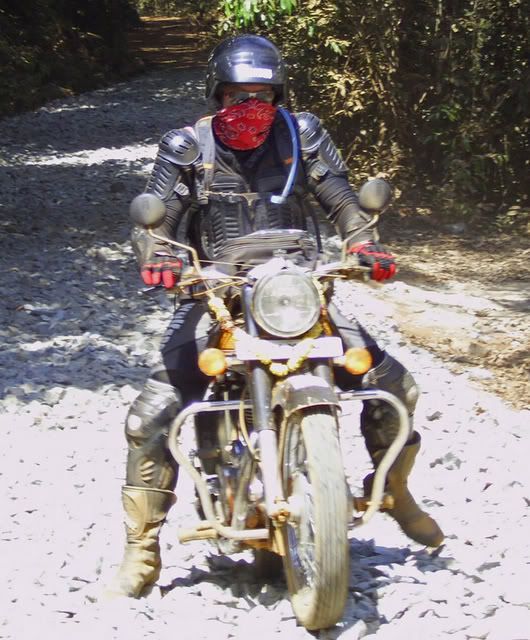
Among those watching from near the bridge was Ali. She was crouched down to one side of the track with her camera, recording everything that happened. We learned about Ali over the next few days. Wherever there was a likelihood of some dramatic event; wherever there was a nasty corner or a sheet of loose gravel; anywhere where there was likely to be a tumble, there you’d find Ali with her camera, waiting patiently for the inevitable. When she wasn’t sitting it out on dodgy corners, she’d be riding on the back of some guy’s Enfield, facing the wrong way, with her long legs and arms at all angles, and her camera snapping. If there was a good camera shot to be had, you could rely on Ali to be there to find it.
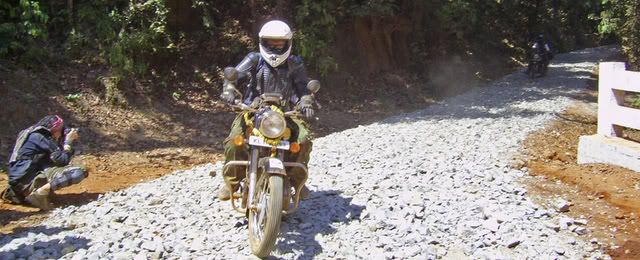
Ali (extreme left), always on the alert for a juicy spill
Hash made it over the stones a little behind me and Larry followed. The bridge offered a pleasantly level bit of surface to rest on. The three of us spent about quarter-of-an-hour hanging around on it, watching the guys behind tackling the hard core, yelling them on and eventually developing something of Simon and Ali’s relish for disaster.
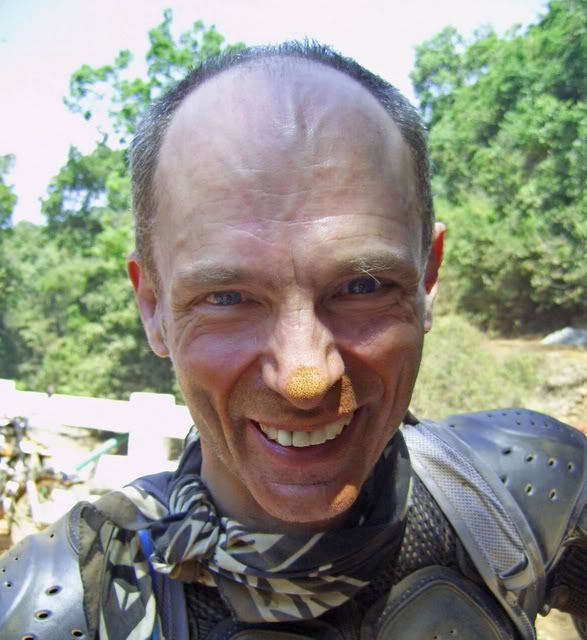
Here's me still covered in dust from the ride up to the bridge
Beyond the bridge, the sandy track continued uphill for a couple of hundred yards till suddenly we came across not only more hard core but an extensive audience of Indian road workers who had clearly not been so entertained in years. My heart sank. I’d done my bit, I thought. I was feeling proud of myself for having made it across the first stretch without dropping the bike. Surely, I had a right to feel smug for a couple of hours without having to undergo a second test.
But having managed it once, the second attempt was easier. And apart from one moment when I got too close to the edge of the road (i.e. the edge of a small cliff) I managed it all quite easily and without my heart relocating itself in my mouth. Hash and I got across, but Larry unfortunately dropped the bike and went down. He’d been uncertain about the trip from the start and was so keen to avoid an incident of any kind, I was afraid this might dent his confidence, but he seemed OK. After a moment, he picked himself up and waved us on. I was beginning to realise that riding over this kind of surface demands attack and not caution if you are going to carry it off well. I was learning a hell of a lot in a short space of time.

Once over the brow of the hill, some three or four kilometres further on, the track turned into a metalled road and once more began to descend steeply through the wooded hillsides. And what a road! A real twister! These were bends to die for! Cliffs or steep banks rose up on the left now, and dropped away to the right. It was a brilliant sun-shiney afternoon. Beams of sunlight were slanting down through the thinly leaved trees and spreading warm dapples all across the road. It was then that I knew I was going to remember today as one of the great days of my life.
My road riding was taking a quantum leap forward too. I was beginning for the first time to understand the practical sense of making late turn-ins. I was also beginning to realise that late turn-ins are not just technically ‘correct’ from a racing point of view but amazing fun as well.
The road rolled on down the mountainside, seemingly for ever. And that was fine by me because I never wanted it to stop. When it did level out eventually onto the valley floor I was sooooo sad. In the village we took another lemonade break at yet another wayside kiosk and had yet another crazy encounter with the local kids. Scores of adults gathered nearby too, laughing and smiling, come to take a curious look at the Westerners in all their strange gear.
But the best of the day wasn't finished. Beyond the village there was more good riding. These roads were just magic. I was starting to string the bends together well now. But there were many blind corners and you had to be hyper-vigilant, ready to swerve to right or left at a moment’s notice. There was very little oncoming traffic but what there was couldn't be seen until it was almost on top of you, and it might be on either side of the road. The tarmac surface was poor, and you had to keep a look out for the worst potholes. but I was beginning to realise that the Enfield on its Dunlop tyres didn’t seem to mind them too much. The road gradually widened out until, eventually, we turned onto a massive National Highway - the widest I saw in all my time in India. And once on this road we were back avoiding the trucks again in their dozens.
We were still high in the mountains and this new highway was full of sharp turns and one or two hairpins. I was enjoying myself so much that I'd run on ahead of Larry and Hash and was riding more or less alone. Then something extraordinary happened. As I rolled around a corner at a good lean, a short woman with two very dark, very wiry children dashed out of the dense trees and down a bank to my left. The two children placed themselves on the sandy verge with their arms held wide while the woman went into a semi-crouch between them and cast some small object across the road directly in front of me. She was ululating as she did so in a high-pitched voice, and as she let go of the object she made some strange vatic gesture in my direction.
It all happened very quickly. Their movements were energetic and ritualised. I thought of stopping but I had a large lorry closely following directly on my tail. The incident puzzled me for ages. I saw nothing like it again while I was in India. I couldn’t decide whether it was some kind of ritualised tribal magic, or just someone in a bad temper, or… What? I asked a couple of Indian guys about it at Om Beach where we were staying that night but neither of them were able to a make anything of it. The woman, her movements and gestures, left such a dramatic impression upon me that I have dreamed about them several times since.
On the valley floor the National Highway straightened out for a long run, inviting you to open the throttle and blatt your way down the highway. The Bullet’s 60 km per hour felt like 150 on my Triumph. Riding interest was supplied by the unpredictable antics of trucks and busses coming the other way

John looking mean and moody after a day's hard riding, and some trucks, of course...
We pulled over among a muddle of stationary trucks, Enduros and busses. On one side of the road, just beyond another road barrier, there was a mobile kiosk and tea stand, on the other there was a petrol station, a good place to fuel up for tomorrow. We saw plenty of road barriers in the course of the journey. Some of them were state broundaries, some were entries into game reserves and some just seemed to be there for the hell of it. I had a soft drink then queued up at the pumps for fuel. The National Highway had been a blast. Despite the trucks it wasn't all that busy. It was wide and easy riding, but it had the potential to be lethal. The trucks were a real menace.
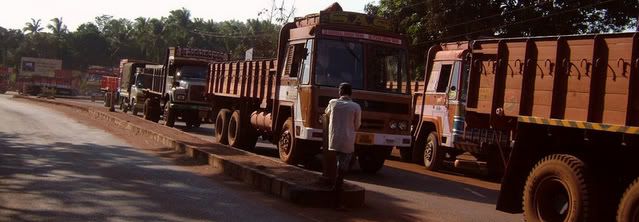
...And more trucks...
While queuing for the pumps we heard rumour of an accident. A young Enduro called Gavin (the youngest rider in the rally), had been bowling along when a truck pulled out for an overtake only yards in front of him. (I swear, these guys just do not look.) That left him with two choices, he could hit the truck or he could run off the road onto the sandy verge. He ran off the road at about 60km/hr, hit a rock, burst his front tyre and rolled off the bike. He said afterwards that he had stood up straight away but then collapsed again immediately as the shock hit him.
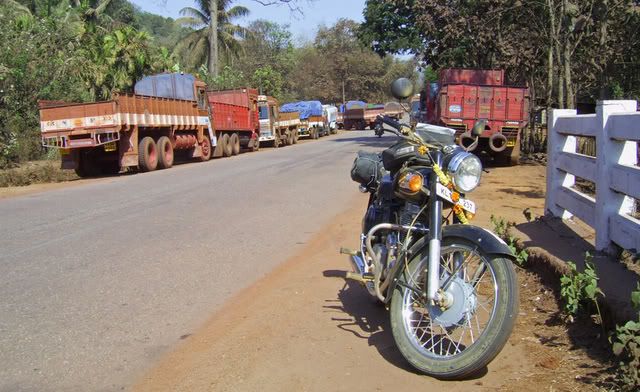
...and yet more trucks
Fortunately, the ambulance was only a couple of minutes behind and he got rapid attention. He came back to the hotel in a neck brace and with a lot of nasty cuts to his face and a split lip which had to be glued together. He was fairly new to motorcycling. I heard that the bike was a write-off, but Gavin was up and riding again on a new machine in a couple of days. [Edit, 2 July 07: Just heard on the grapevine that Gavin's bike wasn't a write off. The mecahnics worked on it overnight and got it back on the road ready for him to ride the following day. Bloody good for them, and for Gavin!] You have to hand it to the The EnduroIndia Crew. They may not have been good at communicating with us over small things, but when it came to matters of importance, they didn't hang about.
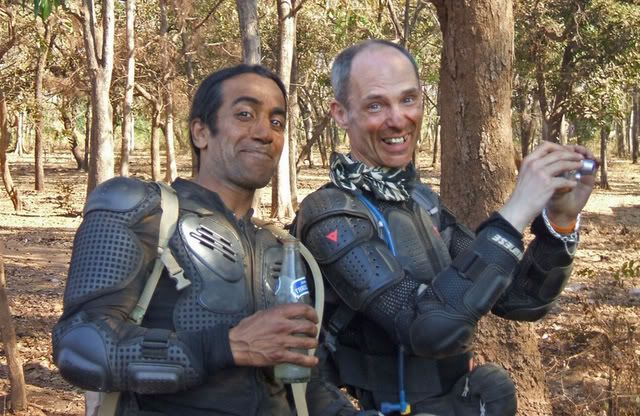
Hash and I
At the pumps I met James. He too had had a bad time. Somewhere, back on the twisties, he’d taken a right-hand bend a little too fast (by his own admission) and ran into a patch of gravel. He’d slid off to the left and made several forward rolls into a ditch. He came out of it with some nasty looking abrasions all the way down his left hand side. He said that his bike was unharmed (sturdy little buggers, these Enfields) and he insisted on riding the rest of the way to the hotel. But when I spoke to him at the pumps he was in a lot of pain and just wanted to get to Om Beach as soon as he could for the evening surgery.

A quiet way to make a living
After filling up we turned onto another wide road, even busier than the last, which took us through some big rolling hill country a few kilometres inland from the coast. It swung lazily back and forth. Coming round one corner, we could see that something was going on down in the dip below. A number of Enduros had pulled up onto a lay-by and were getting out their cameras. Then something colourful caught my eye. A local festival! That’s a familiar sight in India. Indians love to have festivals.
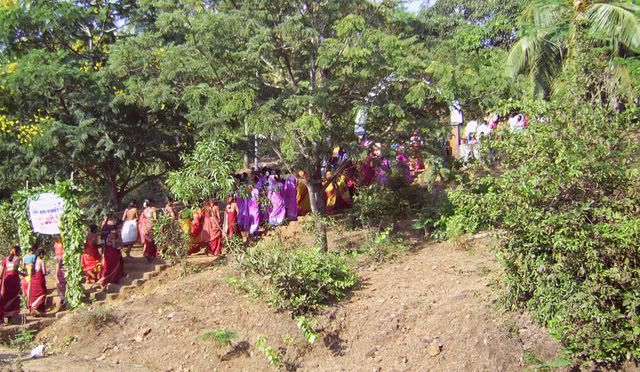
'Festival of Youth'
This was a ‘Festival of Youth,’ we were told. Well, why not? If you've got it, celebrate it! As we arrived, about eighty peope in colourful outfits were standing by the roadside. They were gathered about a couple wearing elaborate theatrical costumes and fierce painted masks. By the time I had got out my camera the festival party had begun to process up a path among the roadside trees towards an ornate temple at the top of the hill. They a vivid splash of colour among the foliage. I was half-tempted to ask if I could come and watch, but I was also tired and wanting to get to the hotel. Larry and Hash wanted to get back too. In the end we rode on, but I made a mental note to come back to India again - soon - and give myself time to explore things like this.
A mile further on, at another lay-by, there was very different kind of celebration: it was a bike meet of some kind. There were some big laid-back looking cruisers and custom bikes among those on display. I think that was the only time I ever saw big cruiser-type bikes in India.
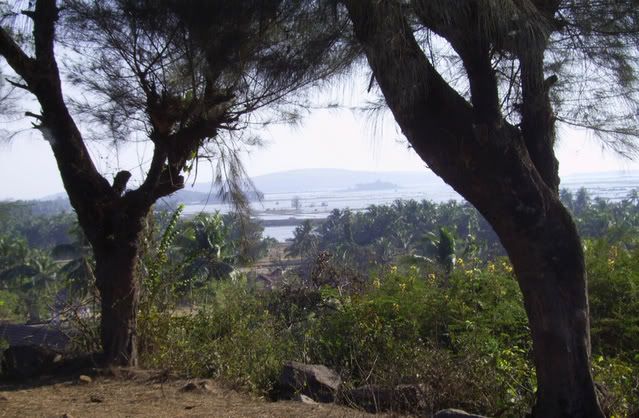
Salt pans in the distance
The road we were following eventually swooped down off the hillside towards the coastal levels and to a wide, watery plain stretching right to a vague horizon. I thought at first that we were looking at more paddy fields for growing rice, but as we got closer they took on more of the appearance of salt pans. Whatever they were, they were huge.
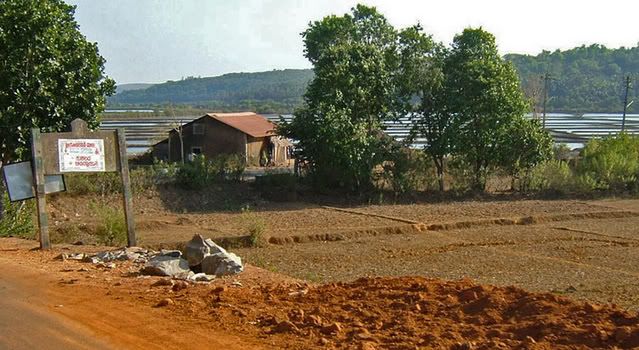
We reached our destination, Om Beach Resort at Gokarna, at about six o’clock. I found my chalet and then went down to reception to pick up my luggage. Our bags and cases were strewn about all over the courtyard. Several eagle-eyed young porters were hanging around and spotted the moment I had identified my baggage, then got to it first. There was the usual quarrel among them about who was going to carry what (one of them, a skinny lad, picked up the largest case, informing me proudly that he was attempting to build some muscle! “Strong man!” he said indicating a straining biceps.)
There were five of us sleeping in one chalet: two guys were lodged in one room, three of us in another. I was sharing with a couple tonight, Phil and Emma, both northerners. So, of course I got the single mattress on the floor. But that was cool! I can sleep most places. The bathroom was a huge tiled space, almost as big as my house back in England. It was certainly big enough for a rugby team. But the main thing was, it had a great shower.

Salt pans near the coast at Gokarna
After sorting myself out, I went down to the open-air snack counter and bar to see if I could find Hash or Larry. Instead, I bumped into the twins, Peter and David. Peter (or was it David?) told me a little about himself, then introduced me to his identical twin brother, David (or was it Peter?), and then to another David, Peter’s brother-in-law. (Confused yet? I was. I never learned to tell David and Peter securely apart.) We spent an hour or so, all of us, talking together on the lawn, under a glorious starlit sky, eating Bhajis and drinking Kingfisher lager. What else! (Despite the great diversity of India, there seems to be a mono-beer culture.) We talked about many things, some funny and some serious, until, as the evening wore on, the conversation turned slowly to personal matters, and I eventually told them all about Di.
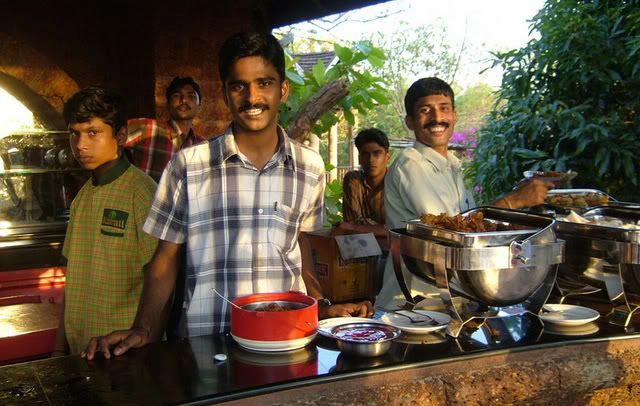
The snack-bar team at Om Beach resort at Gokarna. Wonderful onion bhajis!
Di, my wife, died last year from Motor Neurone Disease. (There’s a lot about Di and her illness and death on my regular blog so I won’t repeat any of the details here except to say that I’m still missing her badly and before she got ill we had planned to do this trip together.) I talked about her for… it seemed ages. The twins spoke personally too about some sad moments in their own recent lives. Then David (or was it Peter) told me something that made my heart pound.
We were looking up at the sky, when suddenly he pointed out the constellation of Orion. For David and his daughter, just as for Di and I, Orion possessed a very special meaning. It was in some sense a symbol of their love for one another as it was for us. Orion, the Hunter, is always visible in England (when it is not overcast by cloud). In winter time he stalks low on the Eastern Hills; but in the summer he rises high, and dominates the whole sky. He makes a powerful presence. Somehow he seems more distinct than other constellations.
Di and I often used to walk together in the evening, over the common land beyond the little market town where we lived, or up onto Windmill Hill. It was always a time of closeness for us. And we always used to look out for Orion and find him in the sky. His enduring presence was reassuring somehow, especially in troubled times, and we both loved his mythology and his name.
Orion is also visible from many places in the world, and for David and his daughter it was a symbol of family togetherness. Often separated by thousands of miles, each would look up into the night sky and know that Orion, so still in the heavens and yet so full of dynamic energy, would be shining quietly over the other wherever they might be.
It was a lovely warm evening. Despite all my best intentions, I finished it off, like the last, in a mild and pleasant alcoholic fug. I’ve never really made up my mind whether I like or dislike what alcohol does to me, but tonight it made me feel good. And I was very tired. Eventually, I keeled over on the hotel lawn with all the chattering Enduros around me and slept there peaceably for at least an hour under the stars with Orion prominent among them.
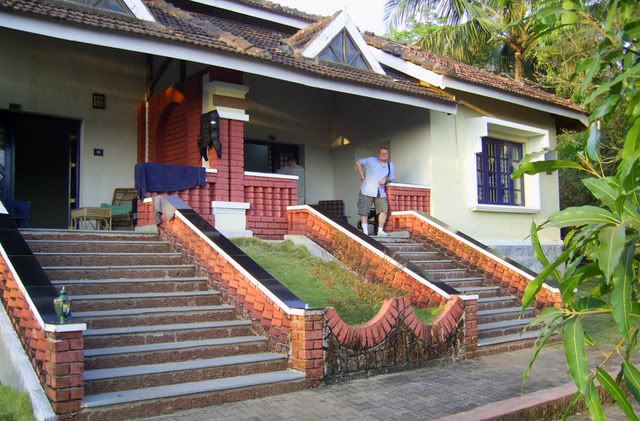
Our chalet with one of the guys I was sharing with
I can just remember getting myself up and stumbling over the now almost-deserted lawn back to my room. I slipped into bed. Phil and Emma were just settling down too. We negotiated about the ceiling fan, which cooled down the air beautifully but was blowing up my single sheet cover into a tempest of activity.
The room was tall and pleasant with a huge glass panel in the centre of the ceiling. The panel was broken in two and one half was missing. Through the gap, among the attic shadows, I could just make out the shapes of huge roof beams. They reminded me of an old barn I used to play in as a child, when the farmer was out of the way. I slept heavily that night, right through until the alarm call at seven o'clock the next morning. I slept peaceably, too, unaware that several of my room-mates had lain awake through half the night wondering about the large animal that was thumping around in the attic above us.

Last edited by sv-wolf on Thu Aug 02, 2007 3:10 am, edited 14 times in total.
Hud
“Man has no right to kill his brother. It is no excuse that he does so in uniform: he only adds the infamy of servitude to the crime of murder.”
Percy Bysshe Shelley
SV-Wolf's Bike Blog
“Man has no right to kill his brother. It is no excuse that he does so in uniform: he only adds the infamy of servitude to the crime of murder.”
Percy Bysshe Shelley
SV-Wolf's Bike Blog
-
blues2cruise
- Moderator

- Posts: 10182
- Joined: Fri Apr 22, 2005 4:28 pm
- Sex: Female
- Years Riding: 16
- My Motorcycle: 2000 Yamaha V-Star 1100
- Location: Vancouver, British Columbia
- sv-wolf
- Site Supporter - Platinum

- Posts: 2278
- Joined: Sat Dec 13, 2003 2:06 am
- Real Name: Richard
- Sex: Male
- Years Riding: 12
- My Motorcycle: Honda Fireblade, 2004: Suzuki DR650, 201
- Location: Hertfordshire, UK
One of the great annoyances of India, if you like taking photographs, is the number of telephone cables that run about chaotically all over the place. The photos below are not mine. Drumwrecker found them on the web and emailed them me a few days ago. I didn't see anything quite as crazy as this myself, but on a couple of occasions I saw something approaching it. I think these pics are fun and they give a real sense of the happy-go-lucky chaos of India.
I suggest that if there are any electrical or telecom engineers with weak hearts logging in to this then they don't bother to scroll down any further.
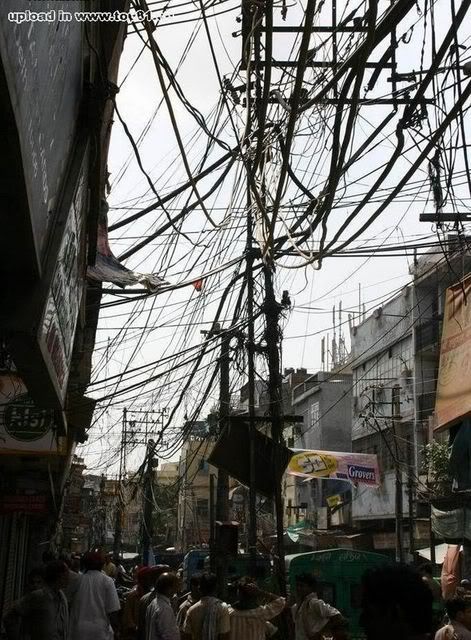
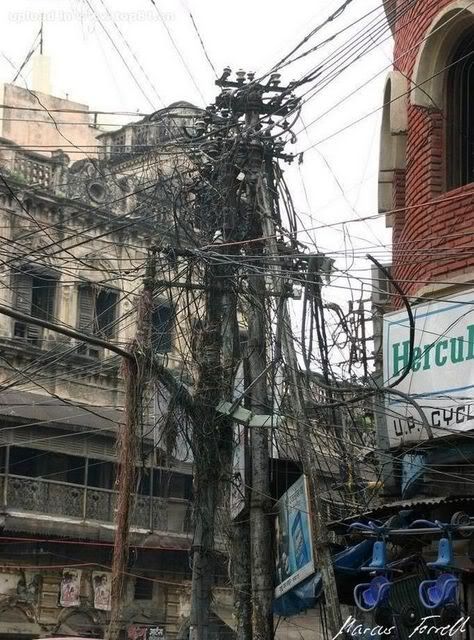
I suggest that if there are any electrical or telecom engineers with weak hearts logging in to this then they don't bother to scroll down any further.


Hud
“Man has no right to kill his brother. It is no excuse that he does so in uniform: he only adds the infamy of servitude to the crime of murder.”
Percy Bysshe Shelley
SV-Wolf's Bike Blog
“Man has no right to kill his brother. It is no excuse that he does so in uniform: he only adds the infamy of servitude to the crime of murder.”
Percy Bysshe Shelley
SV-Wolf's Bike Blog
- flw
- Site Supporter - Silver

- Posts: 899
- Joined: Fri Jul 07, 2006 4:16 pm
- Sex: Male
- Years Riding: 8
- My Motorcycle: '98 Honda Goldwing GL1500se
- Location: Rockford, Illinois U.S.
First it sounds like a fantastic once in a life time trip. Maybe someday I'll be able to do something like that.
Second is the wiring pics. They remind me of some cities in Mexico I have seen. Everybody's tapping off of everyone else. Overloads, brownouts and shorts are a daily event if not several times per day.
Great job.
Second is the wiring pics. They remind me of some cities in Mexico I have seen. Everybody's tapping off of everyone else. Overloads, brownouts and shorts are a daily event if not several times per day.
Great job.
Goldwing 1500se '98
VN500 LTD '07 Sold
VN500 LTD '07 Sold
- sv-wolf
- Site Supporter - Platinum

- Posts: 2278
- Joined: Sat Dec 13, 2003 2:06 am
- Real Name: Richard
- Sex: Male
- Years Riding: 12
- My Motorcycle: Honda Fireblade, 2004: Suzuki DR650, 201
- Location: Hertfordshire, UK

23 Feb Gokarna to Shimoga
Day 3 of the Rally
Start: Om Beach Resorts, Gokarna
Finish: Hotel Jewel Rock, Shimoga
Distance: 219 km
Today we start off with a short stretch of highway, which by Indian standards is very quiet. We then take some beautiful winding roads up the mountains stopping for lunch at India’s highest waterfall: Jog Falls. Once you’re refreshed we’ll crack on towards our final night’s stop, the bustling Indian city of Shimoga. Shimoga sees no tourists whatsoever, and therein lies its fascination for us – it is one of the rare places on earth you can see a city totally unaffected by tourism. It is eye opening and extremely friendly, it is probably one of the only places on earth where the owner of a petrol station asks you in for a coffee.
From the EnduroIndia Road book 2007

Karnataka
The state of Karnataka, formerly known as Mysore is one of India’s most laid back states and one of my favourite places to ride – it is so varied and the riding it offers is wild and spectacular. It is a region of strong contrasts with the modern luxury living of industrial Bangalore at one extreme and the rural, undeveloped farming areas at the other. It also has large expanses of wilderness and many sanctuaries for nature. Karnataka has an awesome history of war and (sic) divide and has amazing ancient architecture too. Some of the oldest and most fascinating buildings in India can be found en route. The state was also the stronghold of Tipu Sultan who put the British in their place on more than one occasion before being finally defeated in 1799. We travel right through Sultan Battery which was where a lot of the fighting took place. When the British took over this place in the early 1800s tigers used to simply walk out of the jungle and take people off the street. In one year it was reported that 600 people were taken in this way.
From the EnduroIndia Road book 2007

“Hello sir, what is your good name?”
You stop, dusty and tired, by the side of the road, in a small town or village under the heat of the Indian sun. You get off the bike. Your thoughts are occupied with the idea of finding a drink, or maybe something to eat. You start to take off your gloves and lid, but before you've finished someone is walking towards you. You look up and you are met with a blinding smile, a hand held out in friendly greeting and: “Hello sir, what is your good name?” And off you go, exchanging information about yourselves.
The way these encounters begin is always the same. It's a ritual, a kind of formula. After shaking the guy's hand, you tell him your name ('Richard' in my case). He hesitates a moment, then: “Ree-chaad,” he says, the unfamiliar vowels and consonants struggling off his tongue. You both laugh and then try it the other way round - and there is more laughter at your attempt to pronounce, ‘Ahmed’ or ‘Ramakrisnan’ (which don’t sound at all like they way they look when written down.) And hell's bells, these people know how to laugh or smile! Their eyes glisten. Pleasure radiates from them. Being on the receiving end of an Indian smile is like being hit by a paintball (except that it's not nearly as uncomfortable).
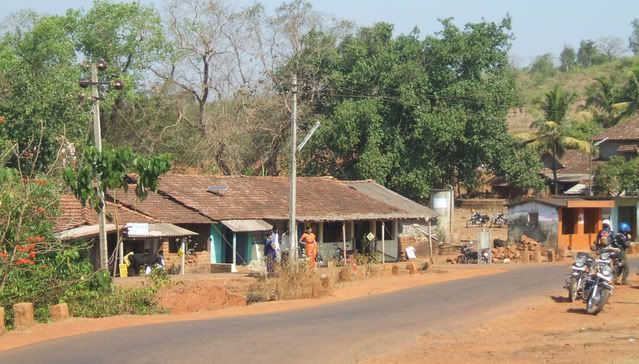
When the guy you are talking to is a Christian, the name-pronouncing game gets a lot easier, because he will be called John or Peter or Andrew. But the game also gets a lot more confusing. Hearing a dark-skinned, Dravidian teenager with a rich Indian accent announcing that, "My name is Andrew," upsets my sense of order. It's like finding a postcard of the British Houses of Parliament on sale in a Helsinki newsagent. (That happened to me once.)
And hearing it always gives me the illusion that the owner and I have something in common. It's not true. Indian Christian culture is Indian, not European, despite the apparently similar belief systems. Nevertheless, I can't help feeling automatically more relaxed with an Andrew or John than with a Ganesha or a Hanif. And the feeling stays with me even after I have told myself it isn't real. It makes me feel like one of Pavlov's dogs, salivating every time the bell rang. Who says we aren't creatures of habit?
The illusory nature of the experience is punched home to me when I realise the familiarity is all one way. Indian Christians only take Biblical names - apart, that is, from the all-pervasive ‘Robinson’ (someone explain please!) So, my own purely Anglo-Saxon handle, 'Richard', is completely off their radar. In my two weeks here, I nevegot to meet anyone who could pronounce it easily.
It's a strange experience, hearing your familiar name struggling off an Indian tongue as though it were still a prototype. It's shocking, because, all at once, you realise that you are now the stranger, the foreigner, the odd-one-out. You're no longer part of the gang; you're the weird new kid sitting in the corner at the party. And as I tried to deal with this experience, my own inbuilt sense of Western superiority rose to the surface, and I'd be faced with yet another piece of automatic thinking - one that needs to be challenged but rarely is.
Round the bar in the hotel every evening, those of us who were taking part in the rally continued to talk in much the same terms as we did at home. But out on the road alone, stopping in towns and country villages, chatting to local people, many of us became very conscious that our commonly held ideas and expectations were wholly at odds with the Indian culture around us. In India, 'normality' belongs to the Indians, not to us. And turning that over in my mind, the uncomfortable thought also came to me that we were now the ones that smelled different to everyone else. I winced at that. Smell is a sensitive subject.
Talking to Indian people in the street made me aware of lots of things I had always taken for granted but had never really examined. (And as I take pride in never taking anything at face value, that realisation was quite humbling.) Ideas of independence, family or possession all have a different meaning here. The value placed on life and liberty is not the same. India forced me to face up to the 'fraud of the obvious,' where things come to seem self-evident just because they are familiar but, when challenged rarely stand up to an honest examination. Feeling my own strangeness among these people made me think in a very focussed way about my attitude to things like relationships, to wealth and to the consumer objects I surround myself with at home. In a single week, I realised, I probably buy more inessential items than many of these people will acquire in a year, or ten years. That is scary.
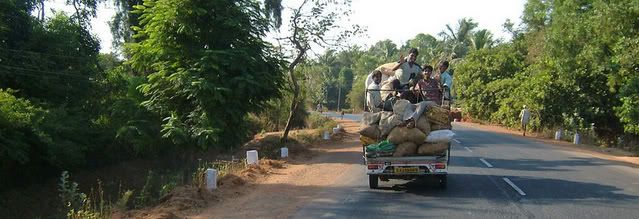
Even scarier is the very apparent fact that Indians enjoy living in the moment a lot more than I do. I was haunted by this realisation, but I was also doubtful. Did that make them more content with their life in general? I wasn't sure. How could I know? The more I saw of India the more I became aware that I was glimpsing only the surface of a very complex and sophisticated culture, one that, despite all the reading I had done, I didn't understand at all.
I have no idea what kind of assumptions Indians make about the world. And flitting through their lives, glimpsing India from the saddle of an Enfield, is not the easiest way to find out. So, the idea continued to grow in my mind that I would have to come back and get to know this country better. I'd only been here four days and India was already weaving its fabled magic about me. I started to think about getting a short-term English Language Teaching Post out here. That would fit in nicely with my plans to travel over the next couple of years. We'll see.

But if what you want to do is to relax and enjoy this incredible country, then riding the Enfield is a great way to see it. Whenever I started to feel frustrated I reminded myself that I was a biker taking part in a rally, not an anthropologist. I was a tourist who just had time to enjoy the odd quick conversation with people on the street. And I had to be content with that.
So, back to the encounter. Once you've swapped names your new acquaintance will then move on to his next question. “What is your country, sir?” he will ask. You tell him. He nods or makes some brief comment. Then, with an air of high anticipation, he asks the million-dollar question: “And do you like Goa? / Karnataka? / Shimoga?” Indians have a great deal of local pride. Get the answer to this one right and you have won a friend for life (for a few minutes, at any rate, until you throw your leg back over the Enfield and set off towards your next encounter.)
India has never been a unified country, and in recent years there as been a huge resurgence of regional feeling. New governments have been elected to the provincial legislatures who identify more closely with local histories and traditions than with the concept of a unified modern state. The new parties tend to pursue very local aims. That's why Bombay is now known as Mumbai, and Madras is now Chennai. The new names aren't new at all, they are old; they are the local names, with local significance. Resurrecting them is a way of defining a local identity and putting up two fingers to the Dehli government. Even as we rode through India on the Enfields we became aware of just how local Indian thinking was.
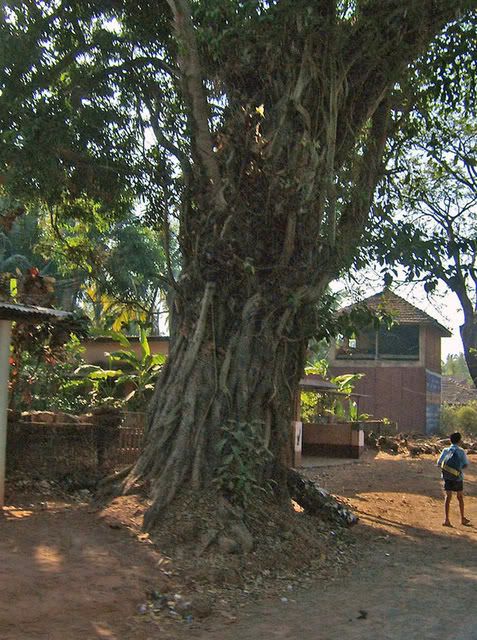
And as we travelled south and up into the mountains we came across more and more people who had very little acquaintance with Westerners. Some, it became clear, had never seen a white person in the flesh before. That surprised me at first. But then I remembered a story told by a friend fifteen years ago when she returned from Eastern India. In one mountain village, she said, she found people who were still unaware the British had left. India is a confusing place: wholly at odds with itself: so wealthy and so poor, so sophisticated and so naïve, so intellectually brilliant and yet often so parochial and unaware.
But all that is beginning to change now with the growth of the aggressive new Indian economy (already the fourth largest in the world, I was surprised to learn). It's a tecnological economy which needs workers who have advanced levels of education. So everywhere you go now, in town and village, there are schools. And in the schools there are hoards of yelling school kids in immaculately turned out uniforms. And though there is still a lot of poverty, the kind of abject deprivation that you still see on Oxfam posters is no longer noticeable on the streets, not here in South-Western India at any rate. Up in Bihar, in the north-east of the country it is a different matter. Down here you see many signs of new wealth and, in particular, of the growth of a very vigorous and confident middle class.
As I opened my eyes on day three of the rally in the Gokarna hotel, a small grey gecko lizard flickered across the wall inches in front of my nose and startled me back into full consciousness. The sun was already up and pouring in through the windows. I’d had a wild (and extremely unlikely) idea the night before that I would get myself up very early this morning and take a solitary trip down to Om beach before breakfast. No chance now. It was much too late. Even though I’d just come from Palolem beach the night before I was missing the sea.
Om Beach is one of many busy but undeveloped beaches south of Goa. In the 1970s this part of the Karnatakan coast became the haunt of travellers (hippies especially) who were turned off by the commercialism of the Goan tourist resorts. Om beach gets its name from the Hindu/Buddhist 'Om' symbol which it resembles in shape. ‘Om’ represents the foundation of all reality. I could have done with some of that. Even some ordinary everyday reality would have been welcome. The whole trip so far had seemed dreamlike. That was frustrating: OK, even if I was a tourist, I wanted to experience India more keenly.
Breakfast was in the sunken garden on the slope below the hotel. The regular food was on offer: milky scrambled eggs and toast for everyone else, idli sambhar for me, followed by some pineapple which looked as though it had been left over from last night’s supper. (I heard later that even the scrambled egg had been curried this morning, so the sambhar probably checked out as the best option.
The talk at breakfast was of some of yesterday's casualties. There were a fair number of minor tumbles but we had all come through without any serious mishaps. American Joe had come off on a corner. 'Missed a gear,' he said, and then he and slid the bike down on some gravel. Suzanne had come a cropper on the rubbley bits of hard core recently laid down by the nuclear power station. Angie had made it right across the rubble and then dropped the bike on the last few inches. No-one had been seriously hurt, and enthusiasm for today's ride was very high.
The sambhar, I decided was really was quite good. Either that or I was doing an excellent job of making a virtue of necessity. After years of coping with a limited diet, I’ve become good at doing that.
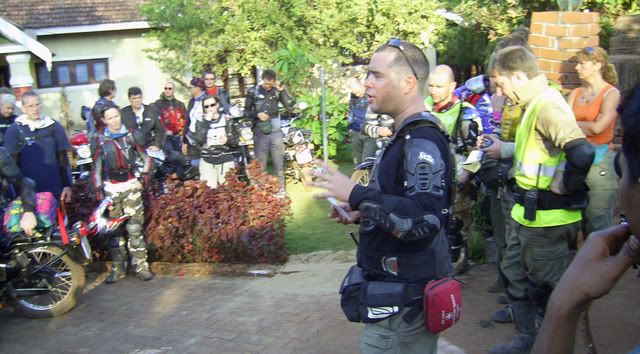
Simon’s morning ‘briefing’
Navigating in India required the same approach. Depending on how you look at it, interpreting the EnduroIndia route plan as you bowl along on the Enfield is an interesting part of the adventure - or it is one big pain in the arse. While I was riding alone – when I had no choice – I enjoyed the challenge. (And felt excessively pleased with myself for managing it so well through the unfamiliar alcoholic mists.) Given half a chance, though, I’d happily forget all about challenges and self-congratulation. It was much less troublesome just to let some other rider do the work and follow on behind. In India, you only have one small part of your brain to read an EnduroIndia route plan and calculate distances – the rest of it is riveted on the idea of staying alive on Indian roads.
I wasn’t alone in wanting to let others do the work. That morning we set off in a long sleepy column. What none of us realised as we travelled nose-to-tail through the narrow village streets was that the guys in front were following one of the EnduroIndia ambulances in the (false) assumption that it was taking the same route as everybody else. All the psychological research on the human tendency to behave like sheep clearly hasn’t changed anything, because over half the rally happily set off that morning in the wrong direction. We’d put a half-a-dozen kilometres on the clock before the head of the column realised its mistake and doubled back the way it had come. And just like sheep the rest of us turned round and followed them back again. They could have been taking us anywhere. Baaaa-aaa! That meant that we had to recalculate our ‘starting figure’ once again, so that we could work out the route plan distances! As I said before, alcohol and maths don't go well together in my brain.
After leaving the villages around Om Beach, the first fifty Km or so of the ride were along the main Mangalore road. There was a good bit of dodging in and out of the traffic, but as the EnduroIndia road book said, this stretch wasn’t as busy as some we had already survived or others we would hope to survive in the future. But it was busy enough!
The towns we passed through were less cluttered and not so densely populated as those we had seen in touristy Goa. But they all had their complement of yelling kids who lined up along the road for a high-five. You got a clear idea of their different temperaments as you rode by at about 10 mph with your hand out. There were those that were totally up for it; they’d give you a huge whack as you went by, and then dance around clutching their sore hand, laughing for a few seconds before trying the same thing on the next rider. And there were those that stood there timidly, hardly daring to hold out their hands at all. They would only step forward at the last minute and then fail to make contact by several feet.
It was real fun to enjoy this with the kids. In many ways it was the kids who made the trip so special.
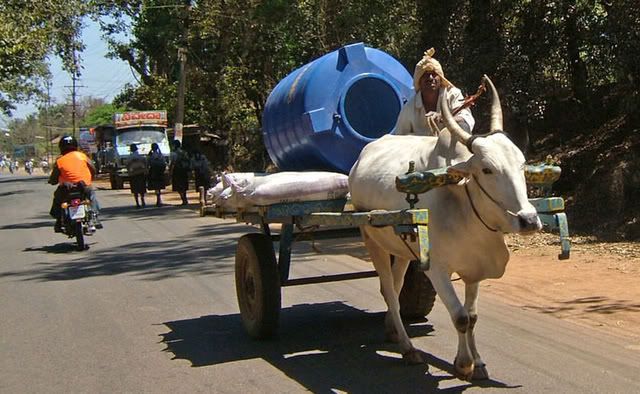
I can't help saying this again. By every principle of rationality I have ever understood, the behaviour of Indian drivers is deeply, deeply psychotic. But despite all the abundant evidence of craziness, I couldn’t, and still can’t, get upset or appalled about it. There were a few Enduros that stormed about a bit at the bar in the evenings, expressing their exasperation and disapproval, but most of us quickly adapted to it pretty quickly. That morning, riding along the road to Honnavar in the glorious Indian sun, I was even beginning to appreciate Indian road manners a little - maybe I was even beginning to enjoy them. That was a thought that had been sneaking around in the corners of my mind for a day or so. It took a while, but finally, I admitted it to myself: yes, all this near-suicidal mayhem was a real hoot!
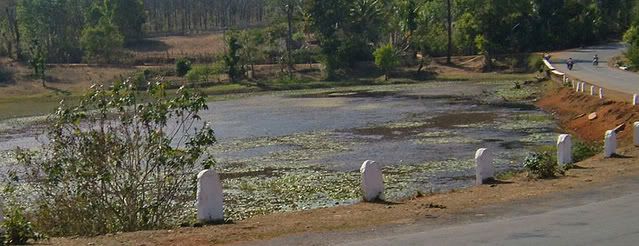
In one way, Indian driving is too wildly surreal to be taken seriously. It somehow belongs more to the amusement arcade or X-Box than to the potentially painful and fatal world of solid 3D existence. You have the impression that, yes, any minute you might lose a limb or your life, but what the hell! The game goes on, and anyway you have six lives left and the worst that can happen is that you will have to go back to level one and start again. Maybe the Indians discovered cyberspace centuries ago. Indian metaphysics is so deeply sophisticated that it wouldn’t surprise me.
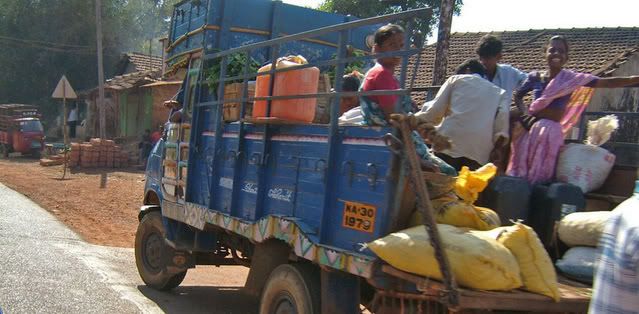
We took a break on the outskirts of the coastal town of Honnavar where the magnificent Sharavathi River flows down the mountainside and empties into the sea. For the next sixty kilometres we would be travelling up the sides of the Sharavathi valley, reputedly one of the most beautiful natural sights in all India. But first it was time to fill up on tea or lemonade or coconut milk from the roadside stalls. These stops were a high point of the trip. They were lively and sociable. Sometimes you’d find up to thirty or more riders pulled up together talking animatedly and swapping stories – you can’t spend an hour or so on these roads without acquiring a plentiful stock of stories. I cautiously mentioned that I was beginning to enjoy riding in Indian conditions and was pleased to find most of the other riders enthusiastically agreeing with me.
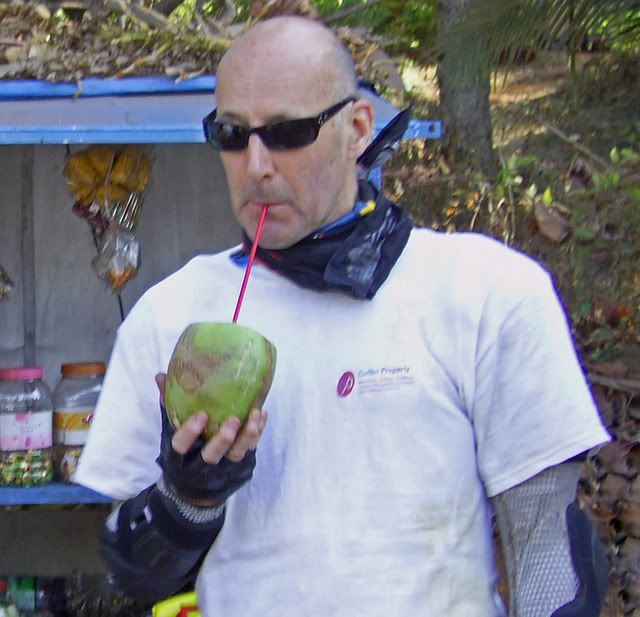
Coconut break on the outskirts of Honnavar
Beyond Honnavar the bikes turned off onto National Highway 206 – which was not so big or so busy. It turned inland, winding steeply uphill away from the main road. Abruptly, we found ourselves deep in the Indian countryside, the traffic and the towns far behind us. And then, ten kilometres from Honnavar, we rounded a bluff and… What we saw took my breath away. The palm forest came pouring down the hillside in a rush and scooped us up into it. It was a visceral experience. The smell of warm greenery was overwhelming. Thousands of tree trunks stood elegantly and perfectly erect all about us. The palm fronds above were huge and perfect like young spring growth. They spread out in every direction and merged into an endless canopy; a sea of glowing emerald green.
The roads that ran through the forest were wide, well-made and lovely. The soil on either side of the roads, and the parent rock in the walls of the cuttings were a deep, spicy red. There was an indescribable depth and richness to the earth here. Above the blazing green of the forest leaves was a deep, blue sky, as intense as I have ever seen. It was incredible.
Riding through the forest was like total immersion. The softness, the redness and the warmth of the soil reverberated inwardly. You could feel the damp lushness of the forest rolling along in your veins. I’ve never experienced anything quite so total. The landscape was utterly simple: glowing palms; rich red soil; tawny, well-made road and the sky above - nothing more. Unlike an English wood, the forest was utterly without clutter or complexity. And it seemed to go on forever.
I have no photographs to show (and neither have any of the other Enduros I asked.) It was much too beautiful to stop the bike; much too tedious to unpack the camera and fiddle around trying to get the best shot. The landscape flowed past me as a single great current and all I wanted to do was flow with it. The Enfield obliged beautifully. If you want to see this amazing place, you’ll have to visit it yourself
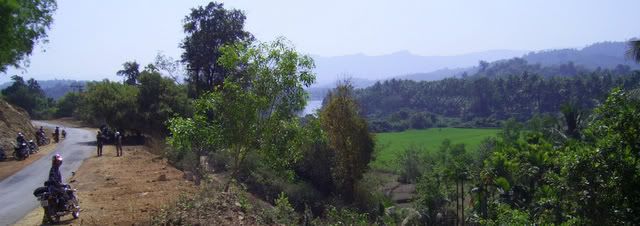
Here and there, I could see the wide, red gash of the road ahead, and the curving line of Enfields sweeping around the bends; the machines flashed occasionally in the unbroken sunlight. The bends were big, lazy sweepers, wonderful to ride. They took us up higher and higher up into the hills and along the valley sides until we were looking down over the loops of the Sharavathi River well below us - thousands of tonnes of water snaking their way through the green of the forest.
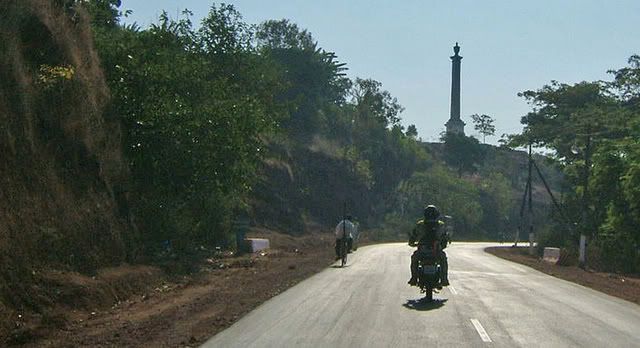
Abruptly and all too soon we emerged out of the palm forest into a much more open landscape, still blisteringly, deeply red but bare and broken. Like the forest, this new landscape was extraordinarily neat and orderly - unlike many of the towns and villages which llooked roughly thrown together by the sides of the road.
The next village we stopped at was a typically scratch built jumble of houses and shops. It was also very lively when we arrived, full of chattering Enduros and curious locals. And standing by the town pump was a cow, just an ordinary brown cow with a broken horn, but for some reason Hash and I decided we wanted to photograph it. It turned out to be an irritatingly unco-operative cow which refused absolutely to pose for us despite our best efforts to herd it into compliance. In the end the photograph became merely academic. We were engaged in an intense battle of wills. The cow versus the two of us. The cow won.

This was the best cow photo we could manage
Beyond the village, the landscape continued as before: steep, rolling hillsides, quite beautiful to see and to travel through. As we rose higher we entered a new zone of lush deciduous forest. The road rolled about drunkenly, but gradually climbed higher up into the hills until we saw a large sign announcing that we were now approaching the ‘Famous Zig-Zags’ stretch of the Sharavathi Road.
The ‘Zig-Zags’ turned out to be our first real taste of what Indian mountain roads can offer. They were a seemingly endless string of tight curves and hairpin bends that wound their way up the steep upper slopes of the Western Ghats and through the broadleaved forest. They went on for mile after mile after mile. Each time I started thinking that we must be near the top, I’d suddenly get a view of them running on further for miles ahead up the mountainside. I was totally wowed!
And for the first time on the holiday (for the first time in months!) I entered into that state of mind that makes riding so much fun. Riding the ‘Zig-Zags,’ in fact, turned out to be one of great biking experiences of my life. The bike flowed with the road and I flowed with the bike. There was no effort and no error. Everything just happened. What did it feel like? Amazing! It was an indescribably wonderful state of mind. You have a sense of being in total physical control of the bike, but the sensation of control flows through you; it doesn’t originate from you. It is yours but you are not really responsible for it.
I think that kind of experience tells us something about who we really are. To our conscious awareness, it only comes now and then when we are fully relaxed and accepting. And there is no point trying to make it happen. That never works. On the other hand, it is actually going on all the time. It is only because we are so wrapped up in our thoughts and preoccupations that we usually don’t notice it. I'm convinced of that. It's because we fail to appeciate that we actually have no separate existence from the thoughts and feelings that are passing through us. Nor are we responsible for those thoughts and feelings. (Where do they come from?).
At bottom, I don’t think I believe human beings are ‘independent centres of consciousness’, I think we are just like everything else - a flow of energy. And just occasionally, like here on the mountainside, our bodies allow us to experience that flow. (OK! OK! This is India. I’m allowed to have thoughts like that here!).
In my innocent youth, I got fascinated with the problems associated with the idea of personal identity: what is it? How do we know we are the same person we were ten years ago? I got so obsessed with it that I took a course in philosophy to try to understand it better. Big mistake! If you want to know who you are, don't think about it, jump on your bike, now, and nail it as hard as you can till you can’t think at all. Just observe what passes through you. Much more revealing! (You can do something similar sitting on your bedroom floor– but being on the bike is a lot more fun!)
This can all be put another way: I was having a "procreating" brilliant time. I’ve rarely if ever enjoyed riding as much as this. I was winging round the hairpins with such confidence and ease I felt like a bird in flight.
About a mile and a half up the zig-zags on a particularly tight hairpin I scraped the Bullet’s pegs for the first time and then again and again on almost every corner and hairpin to the top of this mountain road. It’s not so hard to scrape pegs on the Enfield because they are relatively low but the sensation of taking the bike to its touchdown point and taking it there time after time, gave some kind of physical expression to the experience and highlighted the sense of perfect flow. Towards the top of the hillside I began to get a bit over-confident about it and threw the bike over so far that I dug the pegs into the tarmac a couple of times with some fairly exciting consequences, but I didn’t come off. My adrenalin must have been up as well by that time because It didn't even make be pause to think. I didn’t care a sod.
Here and there among all this riding bliss I caught sight of the Sharavathi River, flowing along magisterially in its tree-lined valley far below. According to all the guide books, the Sharavathi valley is world famous for its beauty. Guide books would say that of course, but I can’t possibly argue with that sentiment. It was a gorgeous sight. I found the blog of some young Indian guys who did a motorcycle journey through the valley (and many other parts of India). It’s a good blog if anyone is interested. Here’s the link
http://usandeep.com/trips/karwar.html
Half way up the hairpin slope we stopped off at a viewing platform that looks out over the river and took some photographs. I’ve posted one here. It’s a popular spot. Exactly the same view occurs on the EnduroIndia official website and in the Indian blog I just mentioned.
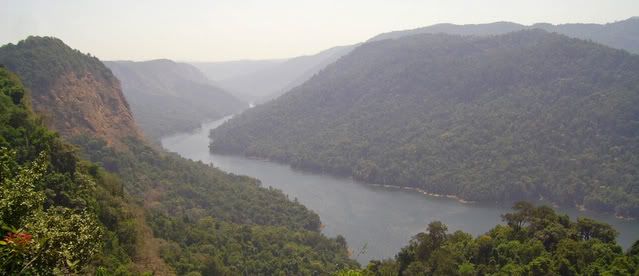
At the top of the hill, the road finally straightened out and for some reason there was yet another open barrier across the road (what are these barriers all about?) together with a couple of stalls inviting us to stop yet again for a drink and to munch a couple of bananas. Hash, Larry and I stopped off for twenty minutes or so until we were joined by Justin, the EnduroIndia Crew’s back marker for the day. So we were right at the back again! Three days out and already being harassed by the back marker had become a familiar feature of our ride. There were about two dozen of us who persistently found ourselves way, way in the rear. We’d constantly pass each other, taking photographs by the side of the road or chatting to locals, or just stopping to enjoy the view.
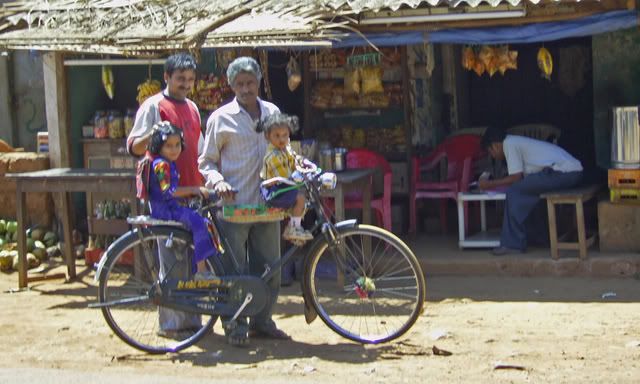
Some kilometres beyond our last stop, the road swung right suddenly and crossed a river on a low bridge. The river’s name was given on a large sign. ‘Sharavathi’ That took me by surprise. So, how’d it get up here when a moment ago it was way down there? Answer: Jog Falls.
The EnduroIndia Road book claims that Jog Falls is the highest waterfall in India, but Wikipedia says it is the 11th highest, so yer pays yer money and yer takes yer choice. I’ve begun to realise that the EnduroIndia Road book is much bigger on wonderment than it is on hard fact. But I can live happily with that. I don’t have any argument with wonderment. Whether it is number one or number one-hundred-and-one, Jog Falls is pretty high.

We had to pay to get into the viewing area to see the falls; it cost 5 rupees (6p). It would be a hundred times that, at least, back home. We parked up the bikes watched several resident cows munching on the wilting garlands round our bikes and went to see the spectacle.
As we crossed the bridge a few minutes back we could see that many of the rocks in the river's bottom were exposed. The water level was very low. Despite the impressive height and width of the falls all we saw was juste a thin trickle of water. Justin told us that the flow shrank to almost nothing at the beginning of the hot season (i.e. now) and that the river and falls are only at their full flow when the monsoons come. Wikipedia says that the water flow is more directly controlled by the Linganamakki dam which is built upstream across the Sharavathi. It says that when the dam opens its sluices the water rushes downstream and falls in four wide segments called Raja (King), Roarer, Rocket and Lady. (I love those names.) It cascades 253 metres over the lip of the falls to the basin below. Wikipedia is very informative, but you’ll get a much better idea of what that all means if you look at a picture (link below). It shows the falls strutting their stuff when the river is in full flood. A bit different to what I saw, huh? Wow!
http://en.wikipedia.org/wiki/Image:Mighty_Jog.jpg
I’d like to have seen it like that. But you can’t have everything, I guess.
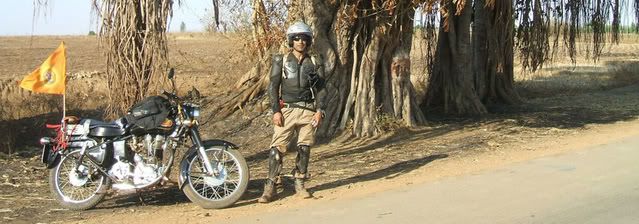
Hash. His bike is sporting an 'India Day' pennant. We were just coming up to India's national day,
and we saw the little flags everwhere.
Beyond the falls we travelled across some wide open country. I was in a mood to put on some speed (Well, you know! We are talking Enfield here!) so I signalled to Hash that I was going on ahead. The roads were lined with magnificent baobab trees (or is it boabab? Or… I can never get this right). I rolled on the throttle and sank into my own thoughts. I don’t remember much after that. I was in a happy state, enjoying the day, enjoying the sun, enjoying the landscape, enjoying the ride. But I do recall one vague thought that kept flitting through my head. I kept thinking that I hadn’t seen any of the features marked on the Route map lately
Then I came across a school. The kids were outside messing around in the playground. I had a tank bag full of pens, so I thought it was time to say hello and get rid of some of them I stopped the bike, and as expected the kids poured out of the school to meet me. The problem was that I hadn’t been particularly organised about packing that morning. I’d just thrown a load of pens into a side pocket in the tank bag along with a load of batteries and my walkman earphones. The spare memory card for my camera was in there as well, together with some money and several other breakable or losable things.
Before I had started to sort all this out, the kids had crowded round. A Westerner on a bike! They knew what to expect: the man with the pens had arrived. I unzipped the side pocket on the tank bag to get the pens out but didn’t get very far. I should have realised. The moment I stuck my hand in, half-a-dozen small hands were in there with mine manically ferreting around for what they could find. I warned them off loudly and zipped the pocket up again quickly.
I knew well enough by now that they wouldn’t nick anything that wasn’t being offered to them. But they would fight like tigers to get hold of the pens before someone else had them. I couldn’t risk other things getting pulled out or lost or broken. I tried several approaches: growling at them with mock ferocity, projecting my voice loudly, staring at them quietly till they calmed down. I tried to get them to stand in line. Nothing worked. Every time I opened up the zipper, in went dozens of small fingers. Then the schoolmaster arrived. He started shouting at them, too.
The schoolmaster was a small man in his fifties, not much taller than the kids he taught. He shouted and boomed in his best schoolmasterly voice. He understood what I wanted and tried to get them to stand back till I was ready. But the kids totally ignored him, and he merely succeeded into working himself up into a temper tantrum. I sympathised. I’m familiar with Indian kids from my home town back in the UK where there is a large first- and second-generation immigrant population. Put a dozen Indian kids together and you have a wild and manic thing of thrashing tentacles and loud yells – totally uncontrollable. The schoolmaster was as keen for them to have the pens as they were but, having lost his temper, he'd lost the game, and from where I was sitting he just seemed part of the mayhem.
In the end I had to use some strategy. I climbed back on the bike among all the disappointed faces and throttled it down the road for a couple of hundred yards and parked up again. I waved to the ones that could still see me. They came running down the road at top speed. That gave me time to get several fistfuls of pens out of the bag. The kids were funny and crazy and gave me big cheesy grins as they understood the trick I had pulled. They scrambled fiercely to get the pens out of my hand, but there was no fighting among themselves, no shoving or elbowing or bullying. The pens went to the biggest or most determined of them or to those of the smaller ones that I could get them to. I tried imagining these kids in fifteen years time employed as truckers and suddenly everything about the style of driving in India seemed to make sense.
Some time later that afternoon those vague doubts about the lack of identifiable landmarks began to get more insistent. With all the recalculation I’d forgotten what my starting figure was, so I couldn’t work out how far it was to the next marked turning. And besides that, I hadn’t seen any of our Enfields for over half-an-hour. I was pretty sure that I was lost. Well, sort of sure. Being sort of sure is worse than being properly sure. I didn’t know whether to carry on and see if I could spot something marked on the Route map, or go back and try and pick up from my last definite reference point. Sometimes, I am very decisive. But sometimes, I am not. This was one of those ‘not’ times.
As I dislike going back on myself, I just carried on. And while one half of me remained relaxed - happy to be riding along in this lovely landscape, the other half was going increasingly into anxiety mode. I passed through a busy town (still no sign of any Enduros taking a break) and then along a long straight road lined with more baobab trees. At that point, fate took a hand and helped me out of my indecision. With a sudden rattle and cough the Enfield jolted then sputtered to a halt. My options were suddenly much more limited. I pulled up at the side of the road, checked over the bike, decided there was nothing I could do, looked around and then lay down on the grass. When there is nothing to be done, I am generally very effective. I have a strong naïve faith that if I hang around long enough something is bound to turn up!
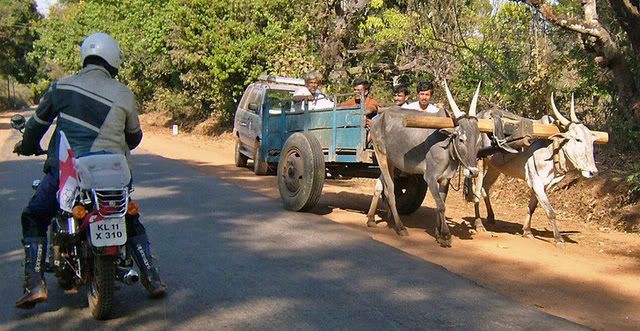
And so it did. What turned up about ten minutes later was an Enduro Mechanic in his bright orange tabard. I was on the right road after all. He got off his bike and walked over to mine. He poked at Beast expertly once or twice, tried the kick-start and then nodded. He didn’t have any English, and I have very little Mechanish, so I wasn’t able to ask him what was wrong. I tried communicating with him in the usual manner of Englishmen abroad, but soon discovered that my ability to mime bike parts was severely limited. We swapped bikes. All this lying around in the hot sun had made me hungry, so I decided to head back into the town I had just come through and find something to eat. I set off, leaving him at the side of the road with his bag of tools. Going back was a good move, because as I hit town I met Hash and Larry coming the other way. And suddenly the place was filled with Enduros.
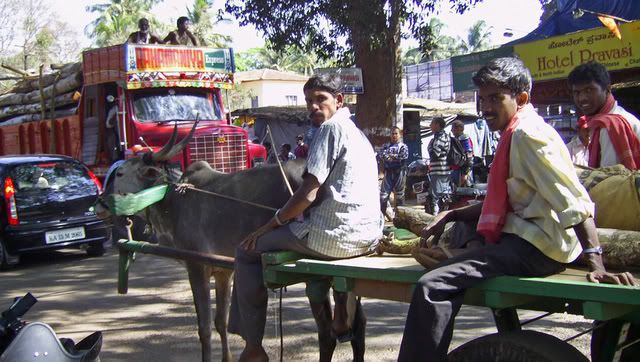
The EnduroIndia crew had recommended that we try the local Thali. ‘Thali’ just means plate. Ask for Thali and you get a metal tray loaded with lots of little bowls of this and that with piles of rice and ‘other things’ scattered about on the tray itself. About half-a-dozen of us got together and found a restaurant. It was a rough, run-down looking place with plaster falling off the walls but it was packed with Indian families, which we took to be a good sign. (Most Indian restaurants are a bit like this. Décor is never an indication of the quality of food on offer.) Some very young waiters were bustling about busily. Hash spoke a little Hindi, so helped me out by asking which of the little bowls had dairy foods in them. That’s a bit issue for me, because I have a big dairy allergy. I wouldn’t have been able to ride for at least several hours if I’d eaten any. The meal cost a matter of pence. I still can’t get over how cheap everything is here.

Family outing
I wanted to get into the town of Ripponpet before four o’clock. At four o’clock the Crew hard organised a ‘get to meet the local school kids session’ in the market square. They do it every year. Most of the rest of the town turns out to say hello as well. I’d seen this event on the film the EI crew had made last year. It looked like fun. A large group of us set off together. I looked out for Hash and saw him up ahead. Time was getting on, so I was pleased when he started pushing up the speed – not at all like him. Soon there were just Hash, myself and another guy bowling on ahead. We rode at a good pace for about half-an-hour until one of the others stopped for a pee. It was then that I discovered that it wasn’t Hash at all but some other guy, who was wearing similar gear, had the same tied-back black hair and the same build. He even had the same coloured team ribbon on the back of his bike.
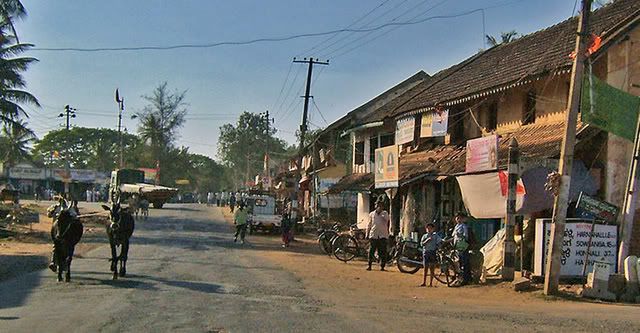
Ripponpet is a creation of the British Raj. ‘Pet,’ in the local language is the word for market. Rippon refers to Lord Rippon, the British aristocrat who founded it. While other countries change colonial names back to local ones when the imperialists leave, India seems to do the opposite. It absorbs colonial influences and makes them its own.
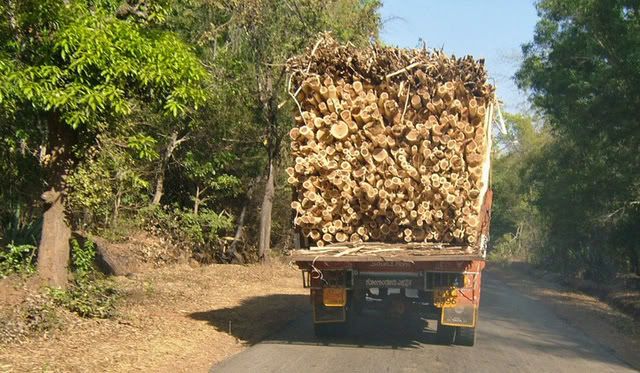
It was four o’clock and there were no hoards of kids gathering in Ripponpet. Something had gone wrong. Rumours started to spread and by the end of the day I’d heard all sorts of explanations. One story said that the school authorities had balked when they heard that there were going to be film cameras present. They didn’t want the kids to be exploited. That doesn’t sound likely to me. It’s not a very Indian way of thinking. Another much more believable story is that when the school authorities were told that EnduroIndia was going to present them with loads of school books (as a big thank you for their hospitality) they were too ashamed at not being able to supply the books themselves and called the whole thing off. That sounds much more likely. So – No kids! But I heard afterwards that the crew gave them the books quietly anyway.
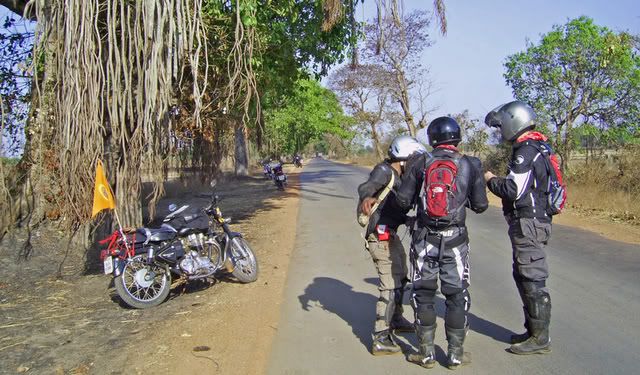
Still lost. OK Where tf are we?
The remainder of the ride started off well. The roads were level, wide open and sunny or they meandered greenly and lazily through the forest. Hash and I rode together all the way. But by the time we got to the outskirts of Shimoga, our final destination, my mood had changed. I was starting to get signs of a bad allergy attack coming on. I felt groggy and uncomfortable. The bike was losing power and it wasn't responding at all well to the throttlle. Then, as we came into town I rimmed the back wheel on a particularly nasty pothole. What damage it had done, I wasn't sure. I was too groggy to be bothered to find out. The bike wobbled, but it continued to run at about fifteen miles an hour. I found the first turning towards the hotel, but missed the second and wandered off blindly into Shimoga's traffic chaos with Hash following on behind. Hash realised something was wrong and took control. It was he who finally worked out where we were and led us back to the Jewel Rock Hotel.
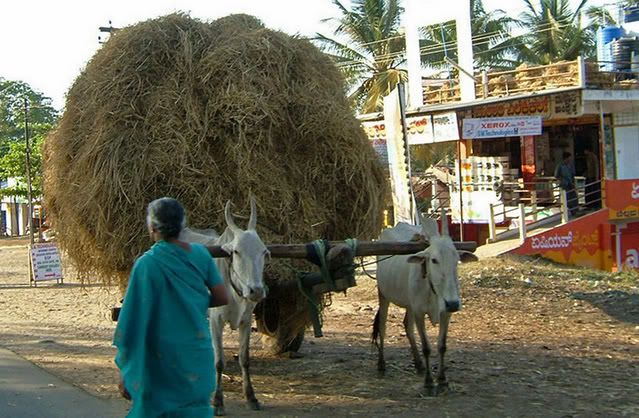
We parked next door to the hotel in a school playground. Groups of kids were hanging around, intrigued by all these Western bikers. They were very persistent. “Hello sir. What is your good name?” “What is your country?” “Do you like Shimoga?” “Will you sign my book?” Well, there you go; it was the first time (and it will no doubt be the last) that anyone ever asked me for my autograph. I found my team leader and reported the problem. Two bikes damaged in one day! Not bad going.
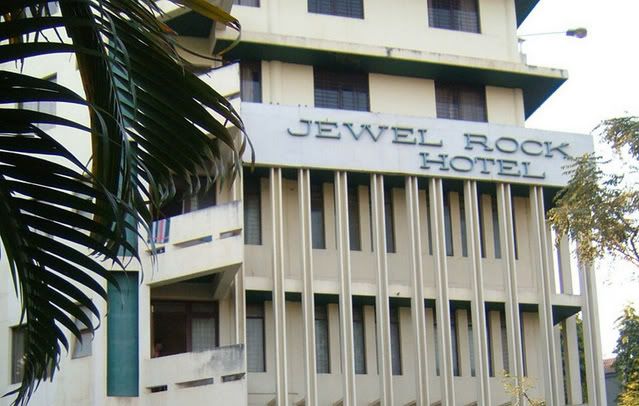
At the Jewel Rock, I was sharing a room with Phil and Emma again. I would share with them from now on until the end of the trip. That meant, of course, that when our room had a double bed in it (most nights), I got the put-you-up mattress on the floor. Occasionally though, a hotel room had two single beds. On these occasions, Emma insisted that I take one of them and slept on the floor herself. She did offer to let me share a double bed with Phil one night, but warned me that it was probably even less of an offer than it sounded. She didn’t elaborate!
Hell, I was glad of a shower! Not just to wash off the grime of the day, but to ease away some of the discomfort I was feeling. I dosed myself up with a load of herbal remedies to take the edge of the allergy attack (It must have been something in the Thali) and went for a quick wander round the town.
That evening we had another open air meal, this time on the hotel roof. Mmmmm! curry! Yummy! (No seriously, it was, very nice. I enjoyed it. It was just getting a bit – repetitive, that’s all.) I met up with the twins and John and Julia. Julia and I agreed to go for a walk round town after dinner to see if we could buy a couple of cushions and some gaffer tape. After three day’s riding on the Enfield, my bum was beginning to feel like of a small pile of elderly chapattis. Not good.
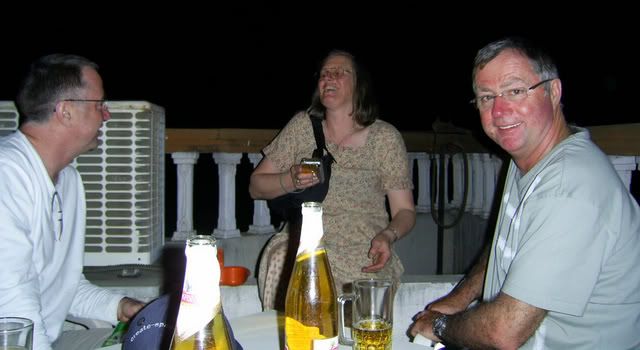
Julia and the twins on the roof of the Jewel Rock Hotel
On our way through the back streets of Shimoga in search of the shopping district we met Hash. He had come out for a wander. Hash is a quiet, soft-spoken guy, very warm and always very pleasant company. I was very pleased when he joined us. He was always eager to look about. This was the first time he had been back to India since he and his family had left for England some 30 years earlier when he was still a small boy. He spent much of the trip looking very thoughtful.
It was already getting late. The streets and sky were pitch black, but dozens of narrow-fronted shops were still open for business. The riotously colourful interiors were dazzlingly bright. Blasts of electric light spilled out onto the alleyways and narrow streets, breaking up the darkness. The shopkeepers eyed us up and down appraisingly.
Not all the traders had permanent sites or stalls, or even temporary ones. We saw several women who carried their ‘shops’ around with them, balanced on top of their heads. We stopped to watch one of these ‘shopkeepers’ deftly displaying her wares to a group of Enduros while managing to keep the rest of her stock in perfect balance above her. She appeared to be very happy. I think she was getting a very good price for her goods. At the close of business she gave us the sweetest smile and bid us 'goodnight' in the Indian manner, placing her hands together, lowering her eyes and giving a little nod. The supermarket balanced on her head didn’t even wobble.
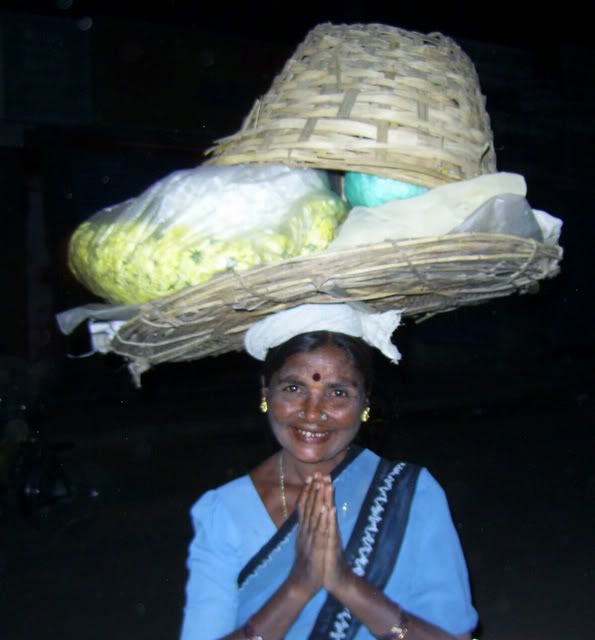
Tell me if this isn't one of the most dazzlingly sweet smiles you have ever seen
We found our cushion seller quite easily and bought several well-upholstered bum sustainers, then joined another group of Enduros who were out exploring the town. Shimoga, it has to be said is a grotty, down-beat looking place. Simon had built up an image of it in our minds as an ‘authentic’ Indian city wholly untarnished by tourism. I now began to understand what he meant. But he was right, it was also a very friendly place, though 'friendly' can have a number of meanings.
So, it wasn’t long before we heard the inevitable voice. “Hello sirs,” it said, “What are your good names?” We turned to see a small, dumpy man standing behind us and to our left. He was looking up at us expectantly. We stared back. So what is this, we wondered.
This, apparently, was our guide for the evening - or at least one of them. Within minutes, we had acquired a train of local entrepreneurs all eager to show us the delights of their city. Unfortunately for them, and perhaps for us, they spoke very little English and much of our communication took place in some form of pantomime. Our 'guides' seemed genuinely interested in us and wanted to know what we were doing here. Explaining about EnduroIndia in broken English and sign language wasn't easy. As more and more people crowded round, we began to realize that these people were unfamiliar with whites. Simon was right – Europeans rarely came to Shimoga. Soon we were surrounded by several large groups of people, mostly young men in their twenties, all pressing close around us demanding information. It could have felt quite threatening. But it didn't.
The dumpy little fellow beside us was, of course, doing his best to protect us from the rest of this rabble. He seemed to regard us as part of his personal territory. Indians manage a trick seldom seen in The West. They ruthlessly exploit every opportunity they can to make money while retaining a genuinely friendly attitude to their punters. And beyond that, they are always searching out opportunities to perform acts of selfless kindness.
When the little man realised that Hash spoke some Hindi, his stream of chatter became unstoppable. He kept alternating between broken English and something else – or possibly several something elses? Many Indians speak several languages.
As soon as we had confirmed, that indeed, yes, we did like Shimoga, he launched into what appeared to be a political tirade, of which I only understood one thing. “India good; Pakistan, very bad,” he was saying, looking to us for confirmation and agreement. Oh whoops! We were straying into a fairly dodgy area here. Political chauvinism! - diversionary tactices required! Things started to feel a little less than casual. Hash manoeuvred the conversation back onto safer ground - or so I thought.
While I was telling several other enquirers what my ‘good name’ was, and confirming for the umpteenth time that, yes, I was English and that I did like Shimoga (sort of), the little chap battened down seriously on Hash with some earnest conversation. When I returned my attention to them both a few minutes later, I could see that Hash was looking extremely uncomfortable and shaking his head. Eventually he turned to me and, in a quiet voice, said, “I think we’d better move on. He’s offering us his daughters. He wants to bargain a price.” We started to move out of the street, but this little limpet of a man was not so easy to shake off. Nor were other members of our by now dedicated train of followers. A small entourage of interested locals accompanied us all the way back to the entrance of the Jewel Rock Hotel. They were, they said, anxious for our safety. As we entered the foyer, the dumpy little guy was the last to leave us, only turning away once we were irretrievably inside the hotel. He seemed not at all disappointed with his lack of commercial success.

Last edited by sv-wolf on Sun Jul 22, 2007 9:55 pm, edited 7 times in total.
Hud
“Man has no right to kill his brother. It is no excuse that he does so in uniform: he only adds the infamy of servitude to the crime of murder.”
Percy Bysshe Shelley
SV-Wolf's Bike Blog
“Man has no right to kill his brother. It is no excuse that he does so in uniform: he only adds the infamy of servitude to the crime of murder.”
Percy Bysshe Shelley
SV-Wolf's Bike Blog